#middle river regional jail
Text

Michael de Adder, The Washington Post :: @deAdder
* * * *
LETTERS FROM AN AMERICAN
January 29, 2024
HEATHER COX RICHARDSON
JAN 30, 2024
With their families now notified, the Pentagon has released the names of the three American soldiers killed in Jordan yesterday. Army Reserve soldiers Sergeant William Jerome Rivers, 46, Specialist Kennedy Ladon Sanders, 24, and Specialist Breonna Alexsondria Moffett, 23, all from Georgia, were assigned to support Operation Inherent Resolve, charged with helping regional partners defeat the Islamic State of Syria and Iraq, or ISIS, to promote stability in the region.
At a press conference today with North Atlantic Treaty Organization (NATO) Secretary General Jens Stoltenberg in Washington, D.C., Secretary of State Antony Blinken spoke of the three lost soldiers, the many wounded, and their family and friends. “Every day we have our men and women in uniform around the world who are putting their lives on the line for our security, for our freedom,” he said. “I am as always humbled by their courage and their sacrifice.”
Blinken reiterated the administration’s determination to keep the Hamas-Israel war from spreading, a signal that the administration will respond to this attack but not go to the extremes right-wing hawks have demanded. “From the outset, we have been clear in warning that anyone looking to take advantage of conflict in the Middle East and try to expand it: Don’t do it,” Blinken said. “[W]e do not seek conflict with Iran, we do not seek war with Iran, but we have and we will continue to defend our personnel and to take every action necessary to do that, including responding very vigorously to the attack that just took place.”
The secretary reiterated that the administration is “very, very actively pursuing” efforts to get the hostages currently held by Hamas released—including as many as six Americans—and create an extended pause in fighting to get aid to Palestinians in Gaza. Its larger goal, he said, is “putting a durable end to the cycle of violence that we’ve seen in the region for generation after generation” and to achieve “an integrated Israel with relations with all of its neighbors, security commitments, assurances that it needs to make sure that it can move forward in peace and security; a Palestinian Authority that’s reformed, and a clear pathway to a Palestinian state.”
Such a plan, Blinken said, would promote security by creating a more integrated region with normalized relations between countries and “where the question of the rights of Palestinians is finally answered.” Stoltenberg responded by thanking Blinken for his “tireless diplomacy…to prevent further escalation of the war in Gaza, your efforts to alleviate human suffering, and your hard work towards a peaceful resolution.”
Over the weekend, officials from the U.S., Israel, Egypt, and Qatar meeting in Paris, France, created a blueprint for a six-week pause in the war while Hamas releases the hostages taken on October 7 in exchange for a much greater number of Palestinians held in Israeli jails. The prime minister and foreign minister of Qatar, Sheikh Mohammed bin Abdulrahman bin Jassim al-Thani, traveled from Paris to Washington, D.C., where he met with Blinken.
David Rothkopf noted today in The Daily Beast that such a plan would end the death and destruction in Gaza and enable Israel to begin a healing process. It would create room to rebuild new leadership for the Palestinians and move Israel toward “the new elections and new government it so desperately needs and deserves.”
Qatar is taking the proposal to Hamas.
Blinken and Stoltenberg both talked as well about NATO and its “unwavering support for Ukraine.” NATO has grown stronger in response to Russia’s attack on Ukraine, and NATO allies and partners have provided more than $110 billion in total aid for Ukraine while the U.S. has provided about $75 billion, Blinken noted (the U.S. has contributed by far the most in military aid).
But the U.S., which has provided key support for NATO and Ukraine, is suddenly faltering as extremist Republicans in the House are refusing to pass a supplemental measure to provide more funding for Ukraine, Israel, and Taiwan and to secure the southern border of the U.S.
Blinken again urged Congress to pass the funding.
“Without it, simply put, everything that Ukrainians achieved and that we’ve helped them achieve will be in jeopardy,” Blinken said. “And…we’re going to be sending a strong and wrong message to all of our adversaries that we are not serious about the defense of freedom, the defense of democracy. And it will simply reinforce for Vladimir Putin that he can somehow outlast Ukraine and outlast us.”
Stoltenberg agreed. “It would be a tragedy for the Ukrainians if President Putin wins, but it will also make the world more dangerous and us, all of us, more insecure. It will embolden other authoritarian leaders—not only Putin…but also North Korea, Iran, and China—to use force. Today it’s Ukraine; tomorrow it could be Taiwan. So therefore it is in our interests to ensure that Ukraine prevails as a sovereign, independent nation.”
Biden appears to have ramped up aid to Ukraine slowly to keep Putin from being able to claim he was at war with the U.S. and to keep him from mounting a full-blown response to such a threat, but as David Frum put it in The Atlantic, Biden “overestimated the time available to keep aid flowing to Ukraine because he underestimated the servility of House Republicans to Trump’s anti-Ukraine animus.” Frum explained: “[T]he background political reality is that Donald Trump is an enemy of Ukraine and an admirer of the Russian dictator Vladimir Putin. As Trump has neared renomination, his party—especially in the House of Representatives—has surrendered to his pro-Putin pressure.”
Back in early November, then a brand new House speaker, Mike Johnson (R-LA) told Senate Republicans that he supported aid to Ukraine but would not deliver it without money for security on the southern border of the U.S. Such a measure was crucial to U.S. security, he and other Republicans insisted, and they hyped the dangers of current immigration policy.
A bipartisan group of Senate negotiators went to work to hammer out such a measure, but once it got close to completion, Trump stepped in to stop the deal, intending to run on fears of immigration in 2024. Republicans are falling into line behind Trump, putting the border deal, as well as more funding for Ukraine, Israel, and Taiwan, at risk.
Meanwhile, the extremist Republicans are in the awkward position of insisting that the United States is in terrible danger from a border crisis but that they don’t want to solve that crisis for almost a year, waiting until 2025 when they expect Trump to be in office.
LETTERS FROM AN AMERICAN
HEATHER COX RICHARDSON
#Letters From An American#Heather Cox Richardson#war in the Middle East#American soldiers#House Republicans#the Putin caucus#traitors#current immigration policy#air for Ukraine#extremist Republican
4 notes
·
View notes
Text
The Gods and The Rivers (session 2)
Welcome to recap of session 2 of my Merano campaign. Session 1 can be found here. Same as last time, all character names are in bold, spells are in italics. Party members are tagged “merano: [character name]”. Locations visited (cities, specific establishments) are tagged “location: [NAME]”. All posts for this campaign are tagged “campaign: merano”.
Introduction:
Last time, our three heroes met. Hugo, the bard; Calypso, the barbarian; and Delphie the wizard. The three are recruited into finding the saboteur of a goodberry fountain at the Akonerry Academy of the Arcane, that feeds the entire region. Meeting with the groundskeeper and the student team tasked with its maintenance, they navigate the tunnels underneath the school. First fighting off two merrows left behind as a distraction. The actual saboteur is found in the mechanism room and the party successfully fights and captures him before he can do any more damage or get away. They double back and turn him over to the groundskeeper. Who in turn, hands him over to the city guard. The three then take the night for themselves.
The Next Morning:
Opening on the early morning in Kerras, the fresh morning sea-air blowing up off the ocean, the city is just starting to wake up, and a large fluffy white dog knows where she’s going. Nimbus comes to the front door of the Screech family house, sits, and barks once. Apolla Screech answers the door and isn’t sure what to make of it when a disembodied voice comes from the dog at her front step and asks for Delphie but she seems to know the dog and follows along without any questions. Stranger things have probably happened since she picked up wizardry.
Sabine’s voice coming through the collar catches her up. The rogue has woken up and is in the city jail but is refusing to talk to anyone, except the people who captured him. He’s willing to blab but, principally, he considers it cheating for anyone who didn’t go to the effort of actually capturing him to interrogate him. She’ll see them when they get back to the jail.
They collect Delphie and Calypso, catch them both up, and make their way back into the city to the jail. It’s early and Sabine is clearly annoyed but if it gets any useful information she’ll put up with it. All the nearby cells have been emptied, so the rogue is out of earshot of any other prisoners. There’s a cleric standing guard outside of the cell helping to maintain an anti-magic field to keep him from teleporting away. He’s an insanely old half-elf, scrawny with a bulbous nose, the longest beard ever, purple wizard robes, and a big old’ warhammer. Delphie recognizes him as Marasmius Elcarim.
However, the anti-magic field is giving Delphie vision problems.
The rogue has had his armor, weaponry, and any other items confiscated. He’s standing in the middle of his cell, arms crossed, back to the bars. He sneers at Sabine and shoos her out. But Marasmius gets to stay because there’s no way they’re dropping the anti-magic field.
He immediately opens up, willing and ready to blab. When asked his name, he gives it, his name is Nariav. Why did he do it? Easy. He was hired to. Well who hired him to do it? The Virastis, that noble family up in Feolinn. Okay but why would they want to sabotage The Cornucopia? He was one of many people hired to cause distractions up and down the coast so no one will pay attention to whatever it is they’re planning. What are they planning? Okay, let’s calm down a bit, he was a random hired hand, they didn’t reveal their entire master plan to him. Still, why are you telling us all this? Seems risky. He’s been caught, he’s already a dead man walking, the Virastis are going to kill him no matter what he does at this point.
But, well, why did you agree to take the job? Yeah, your were hired, but, what were they paying you with? …They were going to turn him back into a god. At this point Nariav shuts down and it’s not like the party believes that particular yarn. Though Marasmius hears this and tries to speak to him in Celestial. However, Nariav is downright insulted by this and replies in a different language that nobody recognizes and sounds like birdsong. But as a last attempt for his death to actually hurt the people who sent him to slaughter, he’s going to try and fuck them over.
The only thing left he has to give them is to ask the guards for his medallion. It marks him as an agent of the Virastis. Maybe they can get some use out of it.
It comes up in conversation that ‘oh hey, is The Cornucopia fixed?’, Marasmius reassures the group that it’s been resolved. With that, they decide to go meet back with Sabine and call Syd back in to keep up the anti-magic field.
The four of them go back to find Sabine and fill her in on what Nariav told them, including asking for his medallion. She goes back to get his confiscated items from the guards and comes back with what he must have been talking about. The conversation moves out of earshot into a sideroom. What she pulls out for them to see is a piece of dark scrap leather with what can only be described as a light green enamel pin with gold lining. It could be the Virasti family crest but if so it’s considerably simplified. Marasmius casts a quick Detect Magic on it and finds the scraps of leftover purple divination magic on it, the guess is that it’s from a Scrying spell and that it must have been either cloaking itself or dispelling a cloaking.
Everyone puts their heads together on what to do next. It wouldn’t be too hard to get to Feolinn, they are currently in a port city and there are four different rivers that connect up to Feolinn. So by sea it is. Sabine says that the Academy will secretly endorse your efforts as thanks for your help and that she’ll be sending updates as things happen. Delphie wants to help though she does bring up the fact that she’s currently a student and can’t miss class. Sabine points to Marasmius and asks ‘Hey, Mirasmius, do you need a TA?’/ ‘Yeah!’/ (Pointing at Delphie) ‘Well, you’ve got one!’ So Marasmius gives Delphie his first wizard hat and robe, they’re tattered but with love.
Before leaving town, the group decides to stock up at Fantasy Cabela’s down by the docks. Calypso covers the essentials and Hugo buys fudge. Delphie manages to find an Alchemist’s Kit and decides to go for it.
Now, as a former ‘sailor’ Calypso takes the lead to find someone headed up to Feolinn. It doesn’t take long before they find The Dapper, a river boat that’s made port in Kerras to pick up a shipment. Dante Rose, the first mate, knows Calypso! They were drinking buddies for a little bit years ago. Dante says he’ll talk to the captain and see if they can tag along. He disappears for a few minutes, but comes back with Captain Monpress in tow, who is willing to let them join them as they sail to Feolinn under the conditions that they stay out of the way and feed themselves.
The Dapper is a modestly-sized river boat with a hold, a flat deck with a low railing to make some spots for oars/poles, and only one sail. The party decides to just find some space below decks and keep out of everyone’s way. Not much happens that first day once they’ve set out, sailing Northeast along the coast to Therane so they can take the Starfire River up to Feolinn. So belowdecks, they decide to make ramen on Hugo’s head for dinner, just sort of balancing a pot on top of the diving suit helmet and letting him heat up. After nightfall, when the crew is taking a break, Dante pokes his head down to invite them all to join them for a drinking game. Marasmius puzzles over the offer and asks the group if any of them are of drinking age. (They all are.)
The crew is palling around circled up together on the deck having a good time and explain that the game is Gnome’s Knack. There are four different drinks, each worth a different amount of points, the winner is either first to 10 points or last team standing, whichever happens first. The Dapper’s crew offers up Dante and Luka (the ship’s cartographer) for their team. The party nominates Calypso and Marasmius.
Everyone’s having a rough go of it tonight. The Dapper isn’t doing very good but the party is doing worse. It takes five rounds of everyone choking down their liquor, the previous drinks making trying to get anything else down even harder. Though the party loses definitively when Marasmius, thoroughly wrecked by his previous attempts tries to get one last drink down, throws it back up and passes out. The Dapper wins by default but it’s not like anyone’s having a good time about it.
Calypso and Hugo help carry Marasmius back down into the hold and get him comfy. Delphie uses her Alchemist’s Kit to make him something to settle his stomach and help with the hangover. The group decides now is as good a time as any to get some sleep.
The following morning, The Dapper hits Therane, situated on the delta of the Starfire River. Therane is mostly known for its floating bazaar though most locals and any well-travelled sailors will tell you that the bazaar is too touristy and not worth sticking around too long. Though as they’re trying to leave the city, the ship gets held up at a customs checkpoint, much to Capt. Monpress’ annoyance, he runs a tight ship and goes to great lengths that everything is above board. He doesn’t like the implication that he’s doing anything illegal but eventually they manage to get through. Marasmius tries acting casually to figure out what that was about. Capt. Monpress fumes about how apparently Therane is clamping down on a recent uptick in falsified manifests, people trying to sneak things inland.
Skipping ahead, it takes another day to reach The Dapper’s first proper stop before reaching Feolinn, the city of Dire, about a third of the way up the river. Dire is nestled at the point where the Starfire and Sapling Rivers meet and deal mostly in wood and lumber coming downstream from the Causatum Forest at the other end of the Sapling. Though it’s most striking feature is the meteor floating over it, with a tower built on top The crew needs the day to work on unloading cargo and their own general business. The party can go explore the city but they have to be back by the end of the day or they’re leaving without them.
The party disembarks and decides to go find some breakfast, making note of what’s around for them to check out as they go, and stop at a cozy little diner called The Old Tree. The place is run and operated by a pretty centaur man in a cozy sweater who takes everyone’s orders but gets stumped when Marasmius requests falseberry jam for his pancakes. But he checks to see if they have it anyway.
The party decides to hammer out places they want to visit. Of the parts of the city they saw on the walk here, there’s some sort of visitor’s center, a temple to Orsum and another one to Hecare in the exact opposite direction, as well as the floating tower on the meteor. The plan is to go to the visitor’s center first, then the temples, and if they can figure out how to get them all up there, they’ll go to the tower.
Marasmius gives everyone a piece of saltwater taffy before they head out to explore.
#my post#tal plays dnd#campaign: merano#dnd 5e homebrew#homebrew campaign#merano: calypso#merano: hugo#merano: delphie#merano: marasmius#location: kerras#location: the dapper#location: therane#location: dire#i've been dragging my feet on writing my recaps rip
2 notes
·
View notes
Text
KANDAHAR, Afghanistan—As Afghanistan plummets deeper into a devastating economic crisis, the Taliban have declared a war on drugs that snatches away the sole cash crops relied on by many struggling rural families—opium poppy and ephedra, a plant that contains a precursor for manufacturing methamphetamine—putting millions at risk of starvation and potentially alienating the group’s own long-suffering support base.
High-ranking Talibs insist that drugs have been fully eradicated from the country and the ban is a matter of ethics; opium and meth are simply “dangerous for the world,” as one senior narcotics official put it. Farmers, low-level soldiers, and rural leaders say they’ve been told it’s a necessary sacrifice to secure recognition and desperately needed humanitarian aid. But in Kabul, where prices have soared and users are rounded up and imprisoned in hellish so-called rehab centers, dealers and users are adamant that supply is undiminished—and that Taliban soldiers still control the trade.
The road from Kabul to Kandahar—Afghanistan’s former capital in the south, where most opium poppies are grown—is just 300 miles long but takes 15 hours to drive. When we made the trip in October 2022, it was peak harvest time for the region’s famous pomegranates, but the landscape was arid. Clouds of dust and sand periodically swirled around our 1991 Toyota Camry, making it harder to spot craters left by roadside bombs or even the groups of small children kneeling in the middle of the road, begging with hands outstretched to oncoming trucks that lurched to avoid them just in time.
In Kandahar province, we were directed along a maze of rocky tracks toward the Afghanistan-Pakistan border by a Taliban soldier; he had been assigned to us for “protection” at a crumbling local military base. Every river and stream had dried up; the only signs of water access were occasional solar panels, used to generate electricity to pump water from deep underground. Until the ban, this scant water supply was used to irrigate the poppy fields that carpeted the area and provided a rare source of income to Kandahar’s rural poor. Twenty years of war scarred the hills and farms. There are bomb craters, ruined schoolhouses, burnt husks of police cars, and even the grave of a child killed in a U.S. airstrike, but the death toll of the conflict could pale in comparison with that of a newly waged war on drugs.
Having leveraged the drug trade to fund their insurgency for decades, in 2021 the Taliban outlawed the harvesting of ephedra, which grows wild in the mountains and from which ephedrine, a meth precursor, can be extracted, and the following April abruptly banned opium cultivation and production. This move blindsided many farmers in Afghanistan’s poppy-growing heartlands. Standing outside his shed-like motorbike repair shop on the side of the road in Kandahar province, Wakil Ahmad pointed to an empty swath of land behind the building.
“Before, this was a poppy farm,” he said. Six months earlier, just a few weeks before harvesting began, the Taliban told his family that this harvest would be their last. If they continued to grow poppies, they would be fined and thrown in jail. “The fields are useless now,” Ahmad said. “We lost everything. We don’t have any other options. We can’t grow anything else.”
With the country grappling with pariah status and the specter of financial collapse, the decision to eliminate opium poppies and processing of ephedra has baffled Afghans and international observers alike. Afghanistan’s narcotics market earns far more money for its people than any other commodity in the country: the total value of all legal products exported from Afghanistan totaled just $870 million in 2019, which is dwarfed by an illicit opiate market reaching an estimated value of $1.2-$2.1 billion.
With international aid and trade largely suspended, opium and meth became the last economic lifeline for many in provinces such as Kandahar and Helmand. In a country where the public sector minimum wage is under $60 per month, foraging for ephedra can bring in $30 per day, which, although laborious, takes no special skills or investment—traders even travel to pick up the product. In the traditional Taliban stronghold of Kandahar, poppy cultivation raises around $400 million a year for farming families, including the 30-year-old Talib resting his Kalashnikov rifle on his knees in the front seat of our car. The soldier said he has received no salary for the 15 years that he has served in the Taliban forces and doesn’t know how he’ll support his family without growing opium.
The Taliban last attempted to wipe out opium in 2000, with short-lived success. After the U.S. invasion in 2001, production saw a general upward trend, and cultivation spiked in 2017, providing crucial income for insurgents—including, notoriously, the Taliban themselves. Researchers such as David Mansfield argue that it’s highly unlikely the Talib leaders who issued the 2000 ban were trying to artificially inflate prices with a view to cashing in, but as the price of opium increased in the ensuing two decades, they certainly had no qualms openly profiting from it.
The United Nations Office on Drugs and Crime (UNODC) reported an uptick in opium production after the Taliban seized power in August 2021, including a 32 percent rise in 2022. This production was concentrated in the southern provinces of Nimroz, Kandahar, Helmand, Uruzgan, and Zabul, which together account for nearly three-quarters of the total area under cultivation. Kandahar saw 12,300 extra hectares dedicated to poppy in 2022, a 72 percent increase from the year before. Processing of ephedra has also increased since 2017, supplying a cottage industry in ephedrine extraction at hundreds of meth labs across the country.
Back in Kabul, local street dealer Khalid scoffed at the idea that the Taliban have stepped back from the drug trade. Heroin and meth are typically bought in bulk from an area called Shahrak-e Aria (close to Kabul Airport), he said, and he sees “a lot of Talibs there” selling wholesale to dealers. Khalid said he has also bought drugs from a Taliban office in Shahr-e Naw, a largely upscale neighborhood known for its manicured public park but where, just outside the railings, we saw at least 50 men huddled around opium and meth pipes in midafternoon.
While it’s getting harder to smuggle illicit drugs into the capital through the Taliban checkpoints, Khalid said, at one wholesaler where he buys smaller quantities for street dealing, kilo packets of meth are packaged with an official Taliban seal, the symbol of the Islamic Emirate. This, Khalid believes, lets drugs pass through the “Kabul doors”—in other words, they are waved through checkpoints without closer inspection.
Analysts watching the situation closely say they haven’t seen evidence of stockpiling, but domestic availability of illicit drugs appears unaffected even as prices soar in anticipation of future shortages. Vanda Felbab-Brown, a senior fellow at the Washington-based Brookings Institution, said she fears that individual Taliban commanders may exploit price surges to increase their own heroin and meth portfolios, by allowing pockets of production to continue under their control in order to inflate their own profits.
On its own, the uninterrupted supply doesn’t prove that opium is still being cultivated in Afghanistan—Felbab-Brown says it typically takes two years of supply restrictions to affect availability on the street—but it contradicts claims made by government officials that all opium and heroin has been eradicated from the country.
There are other signs that some production has continued with the knowledge and blessing of Taliban commanders. Some farmers in the southern provinces told Radio Azadi last October that they were allowed to go ahead with their harvests, and a major heroin-trafficking operation run by Afghan nationals was busted in India’s Punjab region in January. Whether this is a deliberate attempt to shore up control of a smaller, more valuable trade or simply a case of opportunistic factions exploiting the situation to enrich themselves, Talibs appear to be the only winners of the ban.
Profit margins for opium farmers and sharecroppers are modest—perhaps a few hundred dollars per hectare in a normal year—but as our Talib soldier-escort explained, this far outstrips profits from crops such as wheat. In theory, having opium farmers switch to wheat should help combat what the UNODC describes as “one of the worst food insecurity crises worldwide,” but in reality, the slender margins would leave farmers with little means to buy any other food, let alone medicine or other basic necessities. Alternatives such as pomegranates are better earners, but orchards take years to fruit, making it an impossible ask for communities living hand to mouth. No stakeholder who is demanding that farmers transition away from opium—not the Taliban, the former Afghan government, the United States, or the UNODC—has been willing to foot the bill to cover rural incomes in a way that would allow farmers to transition away from poppies.
Low-level growers stay poor, but those further up the chain make serious money. During the civil war, the Taliban in some areas under their control taxed farmers and smugglers around 10 percent of their earnings, while some warlords and Taliban factions controlled parts of the trade directly. Badly paid soldiers and police officers with the Afghan government demanded significant bribes to spare poppy farms from destruction, while senior officials paid up to $150,000 for governorships in remote posts where they could exploit the trade for personal gain. In the early years of the U.S. invasion, Washington was reluctant to push for poppy eradication, aware this would alienate rural communities and drive them closer to the Taliban; reports even emerged of U.S. Marines guarding poppy fields for farmers. But over the following decades, enemy combatants increasingly relied on drug profits, and the United States switched to spending billions of dollars on counternarcotics programs. This included aerial bombings of suspected meth- and opiate-processing labs and trucks. According to testimony given by Felbab-Brown to the U.K. Parliament in 2020, most of these efforts were “ineffective or outright counterproductive” from an economic, political, and peacekeeping point of view, serving only to impoverish and alienate farmers, pushing them closer to Taliban soldiers who offered to protect their livelihoods.
Most illicit drugs produced in Afghanistan are destined for export. Tons of heroin, meth, and hashish were seized by Pakistani authorities in January 2022, including a record 130-kilogram haul of heroin intercepted by customs at the Torkham border crossing. Demand for meth is also soaring among Afghanistan’s neighbors, including Pakistan and Iran. But plenty of Afghans are hooked, too. Two decades of relentless fighting, brutal terrorist attacks, and economic chaos, followed by the return of the Taliban regime, have left more than half of Afghans struggling with post-traumatic stress disorder, depression, and anxiety. Despair and trauma breed addiction; there are now an estimated 3.5 million drug addicts in Afghanistan—nearly one-tenth of the population.
A string of reports and documentaries over the past year paint a grim picture of violent crackdowns on addicts and brutal conditions inside underfunded rehabilitation facilities, where there is little food to go around and malnourished patients frequently die from disease or the effects of heroin withdrawal.
“They give you no food or water. Beat you like an enemy,” said Khalid, the heroin and meth user-turned-dealer in Kabul, who said he was arrested in one of the early Taliban crackdowns and sent to Camp Phoenix, the former U.S. military base now repurposed as a Taliban-run rehab hospital. “There’s no food for us, so we have to eat grass, but if they see us eating grass, then they beat us again. They say they want to get you off drugs, but it is like torture.”
Potential victims of the crackdown extend outside national borders. Afghanistan supplies around 80 percent of the world’s heroin, including to many European nations where fentanyl, a synthetic opioid, is yet to penetrate the market. There is no evidence to suggest that heroin addiction or demand diminishes amid supply shortages, but in the past, disruptions have seen synthetic alternatives flood the market and overdose deaths soar as users struggle to adapt to massive changes in purity levels.
“There’s an assumption that the Taliban are the biggest gang in town, but transnational organized crime has become much more monopolized, more cooperative, and more powerful since the Taliban were last in power,” said Neil Woods, a former undercover police officer in the United Kingdom who now works with the drug policy reform organization LEAP UK. Woods fears a “fentanyl catastrophe” if the ban is effective. “If they do successfully clamp down on heroin this time, it’ll just be more cost-effective to make a quick shift to synthetics,” he said.
Senior Taliban leaders insist that the drug bans are ethically motivated, but their objections appear selective. Last September saw the triumphant return from the United States of Kandahar native Bashir Noorzai, a notorious drug trafficker and Taliban financier, in a prisoner swap that saw the man known as the “Pablo Escobar of Afghanistan” greeted at Kabul Airport by cheering crowds and senior Taliban officials. In Kandahar, village chiefs, soldiers, and farmers offer a more pragmatic explanation.
“Our leader mentioned that the foreign governments are not happy about us doing poppy farming. They said we needed to ban this to be recognized as a government,” said Ular Majeed, the head of a Taliban outpost close to the Afghanistan-Pakistan border, where he is responsible for 10,000 households in an area rife with cross-border smuggling routes. Now that they’ve fulfilled their end of the bargain, he said, “it’s time for [the U.S.] government to do what they said and recognize us, so you can help us.”
Back in Kabul, Taliban officials categorically deny any such negotiations are underway. “We wish that other countries would work with us to stop drugs and would help us, but we have not had any contact,” said senior counternarcotics official Mun Ali.
In an email, a U.S. State Department spokesperson described the ban as “promising,” albeit contingent on seeing a meaningful reduction in poppy cultivation or meth production. Asked if the United States had engaged in dialogue with the Taliban ahead of the announcement, the spokesperson replied: “As we’ve made clear, we’ll continue to engage the Taliban pragmatically to advance American interests.”
“This is very much a replay of the 1990s. They were making that same pitch, bargaining and consistently hoping that the ban would give them international legitimacy,” Felbab-Brown said. But from an institutional and regime survival perspective, she said, “it fundamentally threatens their ability to hold onto power.”
“The Taliban could be lining themselves up for the ‘well, we’re only growing poppy because you didn’t give us the humanitarian aid you promised’ approach. That’s quite feasible,” said Steve Brookings, a former chargé d’affaires at the British Embassy in Kabul and former special advisor to the U.N. Assistance Mission in Afghanistan. Even if officials want to kick the dependency on illicit income, it may prove financially impossible.
Members of the Taliban are often perceived as less corruptible and bribe-seeking than their predecessors, but the cracks are beginning to show. In Kandahar’s villages, soldiers and rural leaders admit they haven’t been paid in months or years. This may have been palatable while the Taliban were the underdogs, but now they’re in charge of the country’s finances—and it was their decision to ban poppy, many unpaid workers’ sole source of income. Meanwhile in Kabul, Talibs flaunt the trappings of their newfound power, cruising around the city in luxury Toyota Land Cruisers and the occasional Mercedes-Benz G-Wagon.
Asked if Afghan families facing starvation following the ban would receive financial support, Ali, the senior counternarcotics official, replied that, as good Muslims, Afghans know “obeying their leader is the most important thing,” dismissing the question with the flick of a wrist adorned with a huge gold watch. For years, Taliban commanders depended on loyalists to shoulder hardship in pursuit of victory, but if peace fails to deliver security and rural supporters feel betrayed by the widening wealth gap, support may evaporate—and lower-ranking Talibs will need to make a living wherever they can.
“You think the Taliban are good men who would not do bad things?” asked Khalid, sighing bitterly. “Yesterday, they couldn’t afford vehicles, but now they have all these [expensive] cars. They couldn’t afford to get married, but now they have three wives. This is their business: When they come and arrest you and take your drugs, they just give them to someone else to sell.”
Unsurprisingly, the Taliban vociferously deny these accusations.
“Our soldiers and staff fought for 20 years. They will never take bribes,” said Mawlavi Shir Ali Hemaad, the head of investigations at the Taliban’s organized crime unit. “We were the ones wearing jackets full of bombs. We were careless about ourselves, so how can we care about money now? No, never. It will never happen.”
But without food, income, medicine, or access to basic services, the costs of this loyalty will be hard to bear. To hold onto power, the Taliban need to choose their battles. Unless they can generate economic benefits from this ban fast—for the whole country, not just a handful of their own men—a new war on drugs will become a costly political mistake and one that only exacerbates the misery of addicts in Afghanistan and beyond.
3 notes
·
View notes
Text
October 6th 2023
The Collins English Dictionary defines Resistance as a "movement
Resistance movement fighting for freedom, often secretly or illegally, against an invader in an occupied country or against the country's government" [1]
Palestine or is the region that spans from Mediterranean sea to the Jordan river. It was under British mandate until 1948. Before that pivotal year Jews, Muslims and Christians lived together and all held a Palestinian passport.
Now that we are clear about the aforementioned, let’s pick it up where the Brits left it, shall we?
1948
World War 2 is over. Palestine, still under British mandate, is given to holocaust survivors. The US, UK and France stole their land and create the state of Israel, gaining in the meantime a foothold in the middle east.
CONSEQUENCE: The Nakba (Arabic: النكبة an-Nakbah): the violent displacement and dispossession of more than 750,000 Palestinians along with the destruction of their society, culture, identity and political rights by Zionist militias first followed by the Israeli army.
1967
The Six-day war: Israel fight a coalition of Arab states and seizes the remaining Palestinian territories of the West Bank, East Jerusalem and Gaza Strip.
Despite the war being between Arab countries and Israel, those who have lost the most are Palestinians. This war marks the beginning of the longest occupation in modern history (over 50 years) with heavy Israeli military control, separation wall and an ever growing number of illegal settlements all over Gaza and West Bank.
1987
Palestinian imam and activist Ahmed Yassin, after the outbreak of the First Intifada against Israeli occupation, founds Hamas, an acronym of its official name, the Islamic Resistance Movement.
This acronym, HMS, was later glossed in the 1988 Hamas Covenant by the Arabic word ḥamās (حماس) which itself means strength, bravery.
2005
Israeli disengagement from Gaza: 21 illegal settlements in the Gaza Strip were dismantled. Israeli settlers and military evacuated from inside the Gaza Strip.
2006
Hamas win the Palestinian legislative election
2007
Israel start imposing a blockade on Gaza and its population making the strip the largest and most populated open air prison on earth.
Under international law, a blockade is an act of war(regulated by the 1856 Paris Declaration and by Articles 1–22 of the 1909 London Declaration) [2].
CONSEQUENCES: Gaza has been declared war by Israeli occupiers long before October 7th 2023… Based on International law, Gaza armed groups are resistance forces
Following the beginning of the blockade, IDF ( Israel ‘Defense’ Forces) waged several wars on Gaza: 2008–09, 2012, 2014 and 2021… not counting the ongoing 2023 collective punishment.
FACTS:
5,200 Palestinians in Israeli jail before October 7th [3].
Over 5,500 Palestinians were killed from 2005 to OCTOBER 6TH 2023.
The next day, the resistance rose against their occupiers.
[1] https://www.collinsdictionary.com/dictionary/english/resistance-movement
[2] https://guide-humanitarian-law.org/content/article/3/blockade/#:~:text=A%20blockade%20is%20an%20act,the%20terms%20blockade%20and%20embargo%20.
[3] https://www.aljazeera.com/features/2023/10/21/number-of-palestinian-prisoners-in-israel-doubles-to-10000-in-two-weeks
OPINION:
I believe Hamas is an ideology, and you can't kill an idea. The "tunnel war" hasn't started yet and the resistance forces are fighting behind enemy lines (and able to fire barrages of rockets to Southern Israel). HAMAS' military infrastructure is nearly intact, so are theirs troops. The israeli media propaganda keeps lying to the world while conducting illegal Raid in The West Bank who has become a pressure cooker where a third intifada is looming.
1 note
·
View note
Text
Police: Staunton man charged with murder after child dies, investigation ongoing
Police: Staunton man charged with murder after child dies, investigation ongoing
STAUNTON — Police arrested a Staunton man Monday and charged him with murder in the death of a 2-year-old child, according to a press release from the Staunton Police Department.
Christopher S. Hoover, 23, is facing a charge of second-degree murder after police said the child died Saturday.
Authorities arrested Hoover on Monday.
He is being held at Middle River Regional Jail without…

View On WordPress
0 notes
Text
https://youtu.be/IR2E9k_w07M
youtube
ARMENHYL Virginia Process Servers are available throughout the Commonwealth of Virginia!
Process Service - Staunton VA 24401 - Fishersville VA 22939 - Waynesboro VA 22980 - Stuarts Draft VA 24477 - Craigsville VA 24430 - Verona VA 24482 - Weyers Cave VA 24486 - Lexington VA 24450 - Covington VA 24426 - Monterey VA 24465 - Harrisonburg VA 22801 - Charlottesville VA 22901 - Front Royal VA 22630 - Winchester VA 22601 - Culpeper VA 22701 - Elkton VA 22827 - Berryville VA 22611 - Leesburg VA 20175 - Bridgewater VA 22812 - Dayton VA 22821 - Hinton VA 22831 - Broadway VA 22815 - Timberville VA 22853 - McGaheysville VA 22840 - Orange VA 22960 - Madison VA 22727 - Warrenton VA 20186 - Crozet VA 22932 - Lake Monticello VA 22963 - Lovingston VA 22949 - Luray VA 22835 - McClean VA 22101 - Arlington VA 20330 - Reston VA 20190 - Ashburn VA 20103 - Fairfax VA 22030 - Alexandria VA 22206 - Manassas VA 20108 & Surrounding Areas throughout the Commonwealth of Virginia!
Contact ARMENHYL today at [email protected] - (434) 260-1031 - (540) 416-1660!
Visit ARMENHYL at www.armenhyl.com and on social media!
We look forward to our next opportunity to serve you!






#craigsville va#middle river regional jail#verona va#western state hospital#22939#22980#24401#armenhyl#augusta health#hershey chocolate of virginia#shenandoah valley juvenile detention center#shenandoah national park#shenandoah valley#shenandoah valley regional airport#augusta correctional center#augusta county va#west augusta va#commonwealth of virginia#virginia process service#virginia process servers#virginia state police#virginia#mary baldwin university#blue ridge community college#woodrow wilson#virginia school for the deaf and blind#distribution center#churchville va#swoope va#stuarts draft va
0 notes
Text
Ted Bundy
Ted Bundy, born Theodore Robert Cowell on November 24, 1946, was one of the most notorious American serial killers. He is known to have kidnapped, raped and killed at least 36 young women in 1970s and probably earlier. He was executed in the electric chair in 1989. His murders have inspired many novels and films about serial killers.

Photo of Ted Bundy
His mother was Eleanor Louise Cowell, who was 22 years old and unmarried when she gave birth to Bundy. His biological father's identity may never be confirmed, since on his birth certificate the father was listed as unknown; also, some rumours identify his father as his grandfather. For the first three years of his life, Bundy lived with his maternal grandparents and was told that his mother was his sister. He eventually discovered the truth and expressed a lifelong resentment toward his mother for never talking to him about his true parentage. In 1951 Louise met and married Johnny Culpepper Bundy, a hospital cook, and later that year the couple officially adopted Bundy, that took his name. He had a tense relationship with his stepfather, and complained to his girlfriend that Johnny "wasn't very bright” and "didn't make much money".

Ted Bundy’s parents, Eleanor Louise Cowell and Johnny Culpepper Bundy
After graduating from high school in 1965, Bundy attended the University of Puget Sound for one year before transferring to the University of Washington. There, he fell in love with Stephanie Brooks, a wealthy and lovely young woman from California. He was devastated by their breakup, and many of his following victims resembled his college girlfriend. He graduated from the University of Washington with a degree in psychology in 1972.
Attacks and murders
There is no consensus on when or where Bundy began killing women. He told different stories to different people and refused to reveal the specifics of his first crimes. For example, he told his mother that he attempted his first kidnapping in 1969 in Ocean City, New Jersey, but did not kill anyone until 1971 in Seattle, yet told psychologist Art Norman that he had killed two women in Atlantic City in 1969.
Homicide detective Robert D. Keppel and biographer Ann Rule, who had previously worked with Bundy, both believed that he might have started killing as a teenager. Circumstantial evidence suggested that he may have kidnapped and killed eight-year-old Ann Marie Burr when he was 14 years old, but he repeatedly denied. His earliest documented homicides were committed in 1974, at the age of 27. The disappearances all took place at night, usually near ongoing construction work, and the victims were all young, attractive, and with long hair parted in the middle; at most crime scenes there were sightings of a man wearing a cast or a sling, and driving a brown or tan Volkswagen Beetle.


Photos of Ted Bundy's 1968 Volkswagen Beetle, in which he committed many of his crimes. The vehicle is on display at the National Museum of Crime and Punishment.
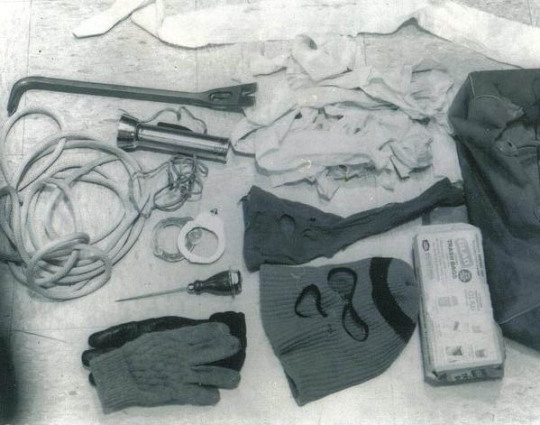
Items found in his car when he was arrested in 1975
His first confirmed attack occurred shortly after midnight on January 4, 1974, when Bundy entered the apartment of Joni Lenz. After bludgeoning her with a metal rod from her bed frame, he sexually assaulted her with either the same rod or a metal speculum. She survived, but with permanent physical and mental disabilities. In the early morning of February 1, 1974, Bundy broke into the room of Lynda Ann Healy; he beat her unconscious, dressed her in blue jeans, a white blouse, and boots, and carried her away. On March 12, Donna Gail Manson, left her dormitory to attend a jazz concert on campus, but never arrived. On April 17, Susan Elaine Rancourt disappeared while on her way to her dorm room after an advisors' meeting at Central Washington State College in Ellensburg. On May 6, Roberta Kathleen Parks left her dormitory to have coffee with her friends at the Memorial Union, but never arrived. On June 1, Brenda Carol Ball disappeared after leaving the Flame Tavern in Burien, near Seattle; she was last seen in the parking lot, talking to a brown-haired man. On June 11, UW student Georgann Hawkins disappeared while walking to her sorority house.
The murders culminated on July 14, 1974, when Bundy abducted two women, Denise Marie Naslund and Janice Anne Ott, in the daylight and from crowded areas. Five female witnesses said that a good-looking young man, who introduced himself as "Ted", asked their help to unload a sailboat from his car. Four girls refused, but one agreed and accompanied him to his car. She saw there was no sailboat and fled. Using the same story, he approached and abducted Janice Anne Ott and, approximately four hours later, Denise Marie Naslund. On September 6, 1974, two grouse hunters found the skeletal remains of the two girls near a service road in Issaquah. After these happenings, King County police disclosed a composite sketch, that was printed in regional newspapers and transmitted on local television stations. These are not the only murders that he committed, as it is believed that he has killed more than a hundred women.
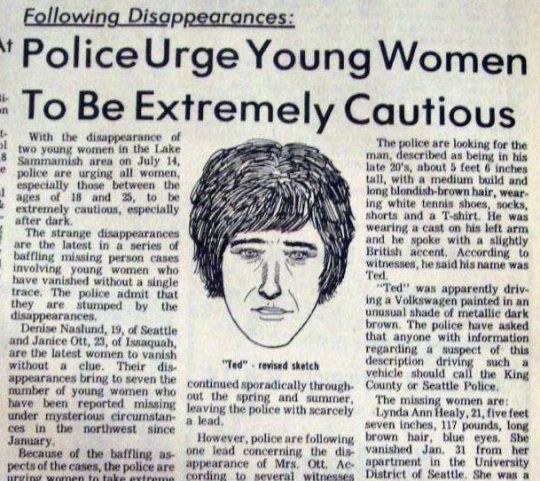
Newspaper from 1974 warning young women about “Ted”, aka Ted Bundy
Timeline of Bundy’s attacks
In 1974
Joni Lenz, age 18, survived the attack on January 4, 1974
Lynda Ann Healy, age 21, died on February 1, 1974
Donna Gail Manson, age 19, died on March 12, 1974
Susan Elaine Rancourt, age 18, died on April 17, 1974
Roberta Kathleen Parks, age 20, died on April 17, 1974
Brenda Carol Ball, age 22, died on June 1, 1974
Georgeann Hawkins, age 18, missing since June 11, 1974
Denise Marie Naslund, age 18, died on July 14, 1974
Janice Anne Ott, age 23, died on July 14, 1974
Nancy Wilcox, age 16, missing since October 2, 1974
Melissa Anne Smith, age 17, died on October 26, 1974
Laura Ann Aime, age 17, missing since October 31, 1974
Carol DaRonch, age 18, survived the attack on November 8, 1974
Debra Jean Kent, age 17, died on November 8, 1974
In 1975
Caryn Eileen Campbell, age 23, died on January 12, 1975
Julie Cunningham, age 26, died on March 15, 1975
Denise Lynn Oliverson, age 24, missing since April 6, 1975
Melanie Suzanne Cooley, age 18, died on April 15, 1975
Lynette Dawn Culver, age 12, missing since May 6, 1975
Susan Curtis, age 15, missing since June 27, 1975
In 1978
Margaret Elizabeth Bowman, age 21, died on January 15, 1978
Lisa Levy, age 20, died on January 15, 1978
Kathy Kleiner, age 20, attacked on January 15, 1978
Karen Chandler, age 22, attacked on January 15, 1978
Cheryl Thomas, age 21, attacked on January 15, 1978
Kimberly Dianne Leach, age 12, died on February 9, 1978
Arrests, last murders and death
On August 16, 1975, Utah Highway Patrol officer Bob Hayward arrested Bundy in Granger (a Salt Lake City suburb). The officer searched the car after he noticed that the front passenger seat had been removed and placed on the back seats. Inside he found a ski mask, a second mask created from pantyhose, a crowbar, handcuffs, trash bags, a rope, an ice pick, and other items. The police did not have enough evidence to detain Bundy, so he was released. Afterwards, Salt Lake City police placed him on 24-hour surveillance.

Ted Bundy's 1975 Utah mug shot
In September Bundy sold his Volkswagen Beetle to a Midvale teenager and Utah police impounded it. Inside the car, FBI technicians found hairs of Caryn Campbell, and some hair strands "microscopically indistinguishable" from those of Melissa Smith and Carol DaRonch. There was sufficient evidence to charge him with aggravated kidnapping and attempted criminal assault in the DaRonch case. Further investigation confirmed that he had not been with his girlfriend on any of the nights when the Pacific Northwest victims had vanished. In February 1976 Bundy stood trial for the DaRonch kidnapping, and after a four-day bench trial and a weekend of deliberation, he was found guilty. In June he was sentenced to 15 years in the Utah State Prison, and after a period of resistance he was transferred to Aspen in January 1977.
While in the Pitkin County Courthouse's library, in Aspen, he opened a window and jumped out, managing to run away. He was a fugitive for six days, until two police officers found him and brought him back in jail. He planned his escape a second time; he sawed a hole of about one square foot between the steel reinforcing bars in his cell's ceiling and, on the night of December 30, stacked books on his bed to simulate his body, climbed into the crawl space and escaped.
After evading, he travelled from Aspen to Tallahassee, Florida, passing from Chicago, Ann Arbor and Atlanta. There, on January 15, he attacked another five women, Margaret Bowman and Lisa Levy who died, Kathy Kleiner, Karen Chandler and Cheryl Thomas who survived. On February 8 he attacked another woman, Kimberly Dianne Leach; her partially mummified remains were found in a pig farrowing shed near Suwannee River State Park, near Lake City. He was arrested four days later by police officer David Lee for having stolen a car.

Two of Ted Bundy’s victims
After numerous trials and three death sentences, Bundy was executed at 7:16 a.m. on January 24, 1989, at the Florida State Prison in an electric chair. Outside the prison, hundres of people cheered, sang, danced and even set off fireworks. His body was cremated in Gainesville, and no public ceremony was held.
Sources:
Ted Bundy | Crimes, Death & Facts | - Britannica
Ted Bundy - Biography
Ted Bundy’s Victims - Women’sHealth
Ted Bundy - Wikipedia
64 notes
·
View notes
Text
Amos Slaughter
Amos Slaughter was a peaceful man. Born of the dustbowl years in north central Texas' Brazos River region. Amos’ family consisted of a woman, a man and two other spawns of which he was the middle. The man and woman were sharecroppers and cotton pickers. Lives came and passed. Bank failure and draught, too. It was hard times for the people of the high plains. Early conquistadors named the river 'Los Brazos de Dios' which translates to “The arms of God.” Circumstance being as it was, His were the only arms to reach out to Slaughter's pack of whelps.
The Slaughter’s story was much the same as the Joad’s story. Interchangeable parts really. No benefactor to the rescue. “The Great War” had ended, the combatants were slowly recovering. Demand for U. S. commodities dropped then were nonexistent. Without a market farmers had no means to pay for machinery they had bought on credit when commodity prices were high. Banks foreclosed on farmers. A collapse whose effect hurt the Well-shod and the barefoot alike, was set in motion. The Slaughters bid adieu to the Los Bravos, packed up the kids, left no forwarding address . Man, woman and pups in tow, they headed for the Golden State.
The Slaughter’s, despite such adversites documented by Dorothea Lange and fictionalized by John Steinbeck, got to California. The man got hired picking fruit and vegetables from Fresno County to the San Jauquin Valley. Sometimes with wife and kids in tow, other times the woman and kids stayed in camps for transients. When Amos and his siblings got older, they joined the man in the field earning less wages. Too young for WWII and a need to see more than endless fields of crops, Amos sneaked away and began hopping freight trains. More experienced boxcar tourists taught Amos how to ride the rails and he adopted the practice as a primary source of education and entertainment. At a rail yard outside of El Paso, Tx. a railroad cop caught Amos and put him in jail. At his arraignment a magistrate gave Amos an option join the Army or 6 months hard labor at the county farm. Amos 'enlisted' in the Army in 1948. Basic training at Fort Polk, La. then Camp Claiborne, La. for his Military Occupational Specialty as a locomotive fireman. His training runs frequently took him from Camp Claiborne to Clovis, New Mexico crossing the Los Brazos de Dios. Amos was back in God's arms.
Following three months advanced MOS training The U.S. Army sent Amos to Ft. Eustis, VA for training in scheduled maintenance of a rail system during war. He was part of two railway battalions responsible for movement of personnel, machinery and war supplies. In war, infantry walks, all other stuff must be transported. When the North Koreans pushed across the 38th Parallel in 1950, Amos’ unit was assembled in Japan for deployment to Korea. Amos was an insignificant cog in a cumbersome machine.
At 25 years, Amos returned to civilian life. Without familial ties, he returned to hoboing and riding the rails once again. A Chicago Northwestern freight train sidetracked Amos’ boxcar at Janesville, WI's General Motors Assembly Plant. He found a place to flop and clean up. With his hobo bag, honorable discharge and a little cash he went to the round house to apply for work. Moving box cars of auto parts to the plant and auto racks of new Chevys to dealership showrooms across the country was the job. Easy peasy.Amos was quite comfortable staying in a cheap flop house, eating at diners and having his laundry done for him. Without having basic maintenance to perform he had time for reading Western romance novels. He identified with Max Brand’s Tom Destry, a quiet man from the Brazos, good with his fists and fast with a gun. Amos also had time for two other activities that were red flags, booze and female companionship. Long story short, Amos remained in Janesville several years. He met a woman and they became a couple. One alcohol fueled evening of 1961 a brash, testosterone rich punk wound up dead on a barroom floor with a bullet wound between his eyes and a pool of blood for his pillow. Amos didn’t run. He dropped the gun on the floor, ordered a beer and waited for the cops. “I did it. I killed the punk” Amos told the cops. The kid, no stranger to the back of the yards or the Rock County Sheriff's deputies, had previously made derogatory comments about Amos’ common law wife. Amos issued him a warning. The kid, 'slow learner' or doubtful of Amos’ sincerity, who knows? For sure he miscalculated Amos' grit. It cost him his life. This evening the kid's verbal assault started it and the bark of Amos' 38 Special ended it.
Amos served 25 years of a 25 to life sentence. I met Amos one hot summer’s day at his residence in Edgar, WI at a “Trail's End” intersection of two gravel roads. His house was a single wide, tired trailer set on cement blocks on 10 acres of prairie grass. As I walked to his door I saw 30 or 40 cases of empty Miller’s Lite Beer cans neatly stored and stacked in their original cardboard containers. Piano music from the local NPR station played clean and clear. It could have been a live performance. I banged on the door once; then a second time more intent on being heard. Amos came to the door barefoot, wearing a layer of sweat and boxer shorts. I asked for a fellow who provided tree trimming services. “Not here, don’t know him.” Thus ended my only contact with Amos.Twelve years passed. I had need of that logger’s services again. I helped him load the dead tree on his trailer and offered to help off-load the tree’s remains. Enroute to his burn pile, he showed me where a cell tower was being built on some land he owned. There across the road was Amos’ old trailer. I told him of my meeting the old guy that lived there. “ Oh! That’s Amos Slaughter,“ he said. “Amos died a few years ago. He’d never harm a soul.” He then told the details I’ve shared here.
Out of curiosity, I looked up Amos’ obituary. Here it is.“
Amos Slaughter
Born February 28, 1930 - Died March 14, 2016
Amos was born in Hood County, TX and was a resident of Edgar, WI. at the time of his death."
Once again, Amos resides in the arms of God.
Disclaimer: This is a fiction. Any similarities of individuals living or dead is purely coincidence.
Property of fxtwng.
12 notes
·
View notes
Photo

I have lived in the “bible belt” south for most of my life. Some of my christian acquaintances, and later, my kid’s christian friends went on “missionary trips” to Latin America. a region that is predominantly catholic. As a recovered catholic (a christian sect) I never understood missions to another christian country.
When I married my second wife (one of five sisters), I began to understand this, because her (now ex) stepfather was a methodist minister, fluent in Spanish and led many missionary trips to Latin America.
On my first (interstate) visit to meet her family while we were dating, he barged into our bedroom without knocking while my wife and I were naked and being intimate. He also walked in on several of his step daughters while they were dressing, and groped a couple of them.
He liked showing off his torso to the guys, and that in his 60s, he could place the palms of his hands flat on the floor without bending his knees. Later, he wagged his semi-hard dick at me in a public restroom at an amusement park.
Because of these incidents, and his frank discussions of how much “fun” the missionary trips were, it became obvious to me that for him the “missionary trips” were free opportunities for pedophile lechers to exploit the church youths and local populations for their own sexual gratification (much cheaper than sex tourism to Thailand).
More on the pervert preacher - His own children would have nothing to do with him, and he was known to be physically and verbally abusive to my MIL.
When he retired from a methodist church across the state, my wife’s older sister invited her mom, with or without stepdad, to move in with her. ( Sis-in-law had recently remodeled her house (due to a flood) to include a seperate suite for her mom.) MIL told her pervert husband that she was moving in with her daughter and it would be nice if he did too.
For a few months after MIL and stepdad moved in, things were calm, but eventually, Preacher Man’s temper got the better of him because he was jealous of the time MIL spent with her daughters.
That night, he was yelling and screaming, and throwing things, when my SIL intervened. SIL (one of the sisters he groped) demanded, with a threat of calling the police, that he leave and never come back.
Nothing more was heard from him until about a month later, SIL was awakened in the middle of the night by a strange noise. Upon getting up to investigate, she discovered that her house was on fire!
Pervert Preacher Man had soaked the cars and carport walls (including the exterior wall of SIL’s bedroom) with gasoline and lit it on fire. SIL and MIL, and the dogs got out safely, but the house and both cars were completely destroyed!
Witnesses testified that they had seen Pervert Preacher’s car drive by several times that night “casing the joint.“
The consequences: After the deed was done, the shithead preacher drove across the river to the next parish and turned himself in to the local cops. He was charged with simple arson - not attempted murder nor aggravated arson! The methodist church bailed him out of jail, paid for expensive lawyers, psychiatric screening, and room and board.
MIL divorced him while the case was being litigated. During this time, he sent vile letters to her and her daughters claiming that he had had sex with all of them! The women filed for a restraining order to prevent further contact from him. The judge refused, citing that his age (now in his 80s) precluded him from being a threat, despite the fact that the year before, he has attempted arson murder!
Eventually, he pled guilty to simple arson, was sentenced to ten years house arrest, with an ankle bracelet, and forbidden to leave the house (provided by the methodists) except for medical visits. The delicious irony is that the court forbade the pervert preacher, defended by the methodists to leave the house to go to church.
Our lawyer explained that this was a better punishment than being sentenced to prison because at his age, the Pervert Preacher would probably serve less than a year before the prison system put him out on the street with no restrictions. Turns out this is a common practice in our state so that elderly prisoner medical expenses can be avoided.
18 notes
·
View notes
Text
The Bombing of Black Wall Street

O.W. Gurley
On the night of May 13th, 1985, as Derek Davis has so eloquently documented in previous issues of The Chiseler, the Philadelphia Police Department dropped a packet of C4 explosives onto the West Philly house occupied by MOVE, a black radical group whose sociopolitical agenda was fuzzy at best. You should read Davis’ stories to more fully understand how and why this came to pass, but suffice it to say in the end eleven people in the house (including several children) were killed, and some sixty surrounding homes—an entire city block’s worth—were allowed to burn to the ground.
At noon on September sixteenth, 1920, a group of anarchists detonated a horse-drawn cart packed with explosives and shrapnel in the middle of Wall Street, killing thirty-eight capitalists and sending hundreds more to area hospitals.
Nine months after the Wall Street bombing and sixty-four years before MOVE, an incident which in a way echoed both events took place in Tulsa, Oklahoma, but with far more devastating results. The Bombing of Black Wall Street, as it was sometimes known, would go on to be just as forgotten, at least in white history books, as both the MOVE and Wall Street bombings.
In 1906, a wealthy black entrepreneur named O.W. Gurley moved from Arkansas to Tulsa, where he bought up forty acres of land on the northern outskirts of the predominately white town. He had a plan in mind, and would only sell parcels of the land to other African-Americans, especially those trying to escape the brutal economic conditions in Tennessee.
Within a decade, the resulting thirty-four square block community, which had been dubbed Greenwood, had evolved into one of the most affluent regions of the state, and certainly the wealthiest and most successful black-owned business district in the country. A few of the new residents had even struck it rich when oil was discovered nearby. Along with the grocery, clothing and hardware stores that lined the main commercial strip, Greenwood boasted its own schools, churches, doctors, banks, law offices, restaurants, movie theaters, a post office and a public transportation system. The houses had indoor plumbing, and, even that early in the history of aviation, six of the residents owned private airplanes. Thanks to Segregation laws which prohibited blacks from shopping in nearby Whites-Only stores, the African-American residents of Greenwood shopped at their own local stores, which kept money circulating in the community, only bolstering their economic strength.
By all accounts, the people who lived there were extremely proud of what they had forged, especially the school system, insisting each and every child of Greenwood receive a full and solid education.
Although generally referred to as “Little Africa” or “Niggertown” in the Tulsa Tribune, Tulsa World, and other local papers, the residents of Greenwood preferred to think of it as Black Wall Street, a nickname that has stuck to this day.
As you might imagine, the much poorer white residents in surrounding Tulsa resented the wealth and success of their black neighbors. This resentment was only fueled by the local papers, in particular the Tribune. Taking their lead from the local chapter of the Klan, more often than not the Tribune’s writers insisted, despite all evidence to the contrary, on caricaturing the residents of “Little Africa” as either stupid, shiftless, shuffling drunks or drug crazed, wild-eyed criminals and rapists running wild in the streets. Meanwhile, editorial writers over at the World even recommended conscripting the Klan to restore law and order to the community.
Combining the reality with the grotesque cartoon proved to be a poor white racist’s worst nightmare. Not only were those blacks in Greenwood subhuman, they were rich subhumans. Jesus God Almighty!
The simmering anger reached the boiling point on May 30th, 1921 when seventeen-year-old (and white) Sarah Page accused nineteen-year-old (and black) shoeshine man Dick Rowland of rape. Page worked as an elevator operator in Tulsa’s Drexel Building, and claimed Rowland attacked her while she was on the job. No one really knows to this day what happened in that elevator, but later investigators who’ve looked into the case genrtally agree there was no rape. Rowland would claim he either bumped into Page accidentally or stepped on her foot—he couldn’t remember. At the time it didn’t matter. The following morning’s Tribune ran a racially inflammatory, lurid account of the fictional crime in which they essentially declared Rowland guilty. A hearing was scheduled for that afternoon, and the paper further erroneously reported the gallows was already being built outside the courthouse for that night’s hanging.
Whether or not a rape had occurred was, to be honest, irrelevant. It was simply the easiest and cheapest way to rile up the angry white masses. If the paper had run an article about economic disparity and racial class resentment turned on its head, all it would have encouraged its white readers to do is flip forward to the sports section.
The residents of Greenwood understood this, and on the 31st, the day of the hearing, a group of men, some of them armed, showed up outside the courthouse in hopes of protecting Rowland. When they arrived they found themselves facing off with the much larger (and better-armed) angry white mob, there to ensure Rowland was hanged, trial or no trial.
Words were exchanged and a few scuffles broke out. A white man reportedly approached an armed African-American WWI vet, and demanded he hand over his gun. When the vet refused and the white tried to wrest it from him, the gun went off, and the riot was underway.
Realizing they were outnumbered, the mob from Greenwood retreated towards home, only to be pursued by the white mob, both on foot and in pickups.
It’s worth noting that the confrontation outside the courthouse had gone on for several hours before the few cops onhand to keep the peace finally called for backup. When all hell broke loose after that gunshot, the cops quickly began deputizing whites on the fly, giving them the authority to make arrests. A few did, and an internment camp set up at the local fairgrounds quickly began to fill. Most of the new deputies didn’t bother, and just started shooting.
As the white mob entered Greenwood, they immediately began looting and torching every building they passed. For the next twelve hours they rampaged through the neighborhood, whooping and hooting as they smashed windows, kicked in doors, took potshots at fleeing residents, and set fire to anything that wasn’t already ablaze. Several eyewitness reports claim two small planes flying over the community started dropping what some believe were kerosene bombs and others believe was dynamite on the already raging inferno. Firemen who arrived on the scene to douse the fires were turned back at gunpoint by the rioters.
The number of white families from nearby neighborhoods—a lot of mothers and children—who gathered around the edges of Greenwood to watch the carnage has led some to believe the attack was planned well in advance, likely by the Klan. They were just waiting for an excuse.
The National Guard arrived shortly before noon on June 1st, but by then most of the rioters had gone home. Along with trying to control the flames, the Guardsmen also began arresting Greenwood’s residents. By the time the fires were put out, all thirty-four square blocks of Black Wall Street had been burned to the ground. An estimated three hundred had been killed, another eight hundred hospitalized, ten thousand were left homeless, six thousand were being held in the internment camp at the fairgrounds, and six hundred businesses had been destroyed. No whites were arrested or charged for their role in the massacre.
Some of the dead, it was reported, were buried in mass graves, others dumped in a nearby river, and still others dropped into the shafts of a local coal mine.
The coverage of the destruction of Black Wall Street in the following day’s Tulsa World included the headlines “Fear of Another Uprising” and “Difficult to Check Negroes.” To this day, white media outlets continue to refer to the incident as “The Tulsa Race Riot,” when they refer to it at all. The Tribune quietly removed the front page story about the alleged rape from all their bound editions, and all police and fire department files about the incident mysteriously vanished.
The day after the riot, all charges were dropped against Dick Rowland (who had been safely hidden away in a jail cell throughout it all), and upon his release he quickly and quietly left town.
Only one of Black Wall Street’s buildings was left standing, and those who survived vowed they would rebuild. They did, too, to an extent, but they were never able to fully reclaim the spirit and status the community once had. Making things more difficult, Greenwood was in a prime location in terms of business expansion. City politicians, anxious to reclaim that land, began devaluing Greenwood property, hoping they might encourage residents to sell out and move far away.
Ironically, the real death blow to Black Wall Street came when Segregation was overturned in Oklahoma in the late ’50s and early ’60s, and most Greenwood residents decided they were happy to take their business to formerly whites-only stores.
Seventy-five years after the massacre, the state of Oklahoma ordered an investigation into the events of May 31st-June 1st, 1921. When the investigation ended in 2001, it was suggested a scholarship fund be set up, and reparations be paid to the families of the victims. A few scholarships were handed out before the program was discontinued three years later, but no reparations were ever paid.
by Jim Knipfel
6 notes
·
View notes
Text
…Bartholomew Anglicus explained that, because the sun was at its apex during Summer, it shone directly on the people’s heads, causing an excess of yellow bile, the dry and hot humour often associated with bursts of anger. Summer heats the body, dries it through perspiration and weakens it, added Bartholomew, causing fevers and other “hot and dry diseases”. Medical treatises included pharmacological recipes designed to appease and reduce sunburns. A tenth-century Anglo-Saxon medical compilation known as Bald’s Leechbook advised to “boil in butter tender ivy twigs [and] smear therewith.” Emollients were commonly used to cure burns, as they are still today.
Women from the elite sought to keep their skin as fair and as white as possible. Skin colour was a marker of socio-economic standing — tanned skin was associated with the peasantry and signalled one’s humble background. Medical treatises, especially the ones concerned with women’s cosmetics, featured recipes to protect the skin from the sun. The eleventh-century De Ornatu Mulierum, attributed to Trotula of Salerno, included a camphor-based balm protecting the skin from the sun. These are the ancestors of modern sunscreen. We do not recommend doing this at home!
To avoid sunburns, medieval physicians recommended wearing wide-brimmed hats and using parasols, when possible. Illuminations of peasants hard at work in the summer heat show them wearing hats, shirtless or with light pieces of clothing, such as on the August page of the Très riches heures du Duc de Berry. This illumination also features a swimming scene. On the bank of the river, one man is naked, drying himself in the sun. His companions are swimming, fully immersed in the water. These men may have been farmers, cleaning themselves and getting some fun cool down after a long day of work.
Medieval people indeed enjoyed getting in the water when temperatures rose. But swimming was not a skill many honed. An ordinance issued in the city of Paris, France, in the late fourteenth century, highlights the dangers of swimming in the Seine river:
Because in these hot days many people have had enjoyment and desire to go bathe in the Seine river, many great inconveniences have unfolded, because many of these people have drowned in the river, which is a very pitiful thing. To reform the foolish minds of young people and other people who go bathe in the river, we forbid that anyone bathes naked in the river, otherwise they’ll be put in jail.
This ordinance is a lovely and fun reminder that medieval people too delighted in swimming in cool streams – or even in highly polluted urban rivers – as we still do today.
Jean de Brie, the fourteenth-century “good shepherd” you might be familiar with if you read this column, recommended that, from June onwards, shepherds should rise early, when temperatures are still cool, to bring the animals to pastures. There, he should make sure they’d find sufficient shade. In July, the shepherds would move the flock to higher elevations and ensure they don’t suffer from overheating. In August, he recommended the sheep stay in their stables in regions where grain had not yet been harvested or else they might devour the wheat! In September, the flock could be released in the harvested fields for them to feed on the hay.
Summer, indeed, was the time of harvests. Harvests usually started in June, when peasants reaped the grasslands to get hay and fodder for their flocks of sheep, their horses and their cattle. In July, they turned to wheat fields. Wheat harvests are heavily featured on the illuminated calendars of late medieval books of prayers. Bathed in a golden light mirroring the colour of ripe wheat, illuminations show peasants hard at work, reaping the ears of grain. Some are shirtless due to the heat, some are drinking from a flask. Staple representations of such harvest scenes can be found in Isabelle of Castille’s Book of Hours, from the fifteenth century.
But the actual period of harvest varied depending on the latitude at which farmers lived. Southern peasants from the Mediterranean basin harvested earlier than northern peasants from, say, England or Germany. The former Mediterranean farmers started reaping in July, while the latter often began their harvests in August. The precise dates of harvests also varied annually, to adjust to weather and the growth of cereals. Calendars rarely reflected these geographical variances, although some occasionally did.
Harvests mobilized flocks of workers who came to the larger estates seeking temporary employment. Most were paid in cash or in nature (often in wheat sheaves). Some were providing “free” labour through the corvées they owned to their lord. Harvests were done by hand or using a scythe or a sickle. Tools were sometimes provided by the lord, or peasants had to come with their own to find employment. Besides reaping, workers made the sheaves, secured with a rope or a strand of rye. The workers usually received wine for the day, because, you know, what could go wrong when doing hard physical work, drunk, in the summer’s heat?
Having reaped the fields, workers had other tasks at hand. They moved the sheaves to storage areas. Then, they threshed the ears of cereals to loosen the grains from the straw. In some regions, such as in Normandy, peasants went back to the fields to reap the straw if it had not already been cut. Straws served to make thatched roofs, mattresses, bedding for horses and cattle – which could feed on it, although hay was (and is) more nutritious for animals. Once the fields were cleared out, the poor could exercise their right of “gleaning”, or harvesting the grains that had fallen on the ground.
Summer was indeed the season of harvests. The harvesters’ days started at dawn before the sun heated too much. Work, agrarian especially, had to be adapted to the hot and dry temperatures to prevent sunstrokes.
But summer was also synonymous with plagues, droughts and fires. The plague waves of the second pandemic that started with the Black Death usually struck in Summer (with exceptions, of course). From the mid-fourteenth to the seventeenth century, across Europe plague mortality peaked between June and September. This mortality trend had not escaped medieval people. Scientists and physicians alike concurred that air, during Summer, was “corrupted and infected,” potentially carrying the “miasma” that was thought to cause plague outbreaks.
Summer’s heat and dryness were fire hazards, both in the wilderness and in cities and towns, as they are still today. During the year 1048, the Chronicle of John of Worcester reports that: “fire in the air, commonly called wildfire, burnt many townships and cornfields in Derbyshire and several other regions.” Summer droughts exacerbated the risks of fires. At the height of summer heat, a royal ordinance provided, the dwellers of Paris had to keep a pot of water next to their door in case of a fire emergency.
Forest fires were a recurring issue for the community of Tortosa, northeastern Spain. Between 1370 and 1462, the city’s officials recorded in their books of accounts the expenses entailed by their efforts of extinguishing these fires. Two-thirds of these fires (67.4%) occurred between July and September, at the height of the dry and hot season. The causes of the fires are only known in 20% of the cases. Every time, the fire had started because of careless people, often shepherds. In Tortosa, making a fire in the forest in the summertime was strictly forbidden.
- Lucie Laumonier, “Summer in the Middle Ages.”
1 note
·
View note
Text
Session Summary - 96
AKA “A whole lot of rub and no tug”
Adventures in Taggriell
Session 96 (Date: 16th October 2020)
Players Present:
- Rob (Known as “Varis”) Elf Male.
- Bob (Known as “Sir Krondor) Dwarf Male.
- Paul (Known as “Labarett”) Elf Male.
- Travis (Known as “Trenchant”) Human Male.
- Arthur (Known as “Gim”) Dwarf Male.
Absent Players
- John (Known as “Ragnar”) Dwarf Male. <Play by Rob>
NPC
- (Known as “Naillae”) Elf Female. <Controlled by Travis>
Summary
- Oathday, 11th Desnus in the year 815 (Second Era). Summer.
- The party begin this session, having just set sail down the inland river headed back towards the Golden Channel. Gim hands over his Lion Greataxe to Galin The Blacksmith on board the ship, to start the work needed to attach the Moon Gem to his weapon.
- The ship arrives five hours later, in the early evening, at the port city of Phlan.

- Captain Lerustah and his men have prepared the ship to look like a common merchant ship, as opposed to an armed military ship. There are less Cult forces on the jetty than the last time the party arrived during daylight hours, and after a cursory check, the ship is allowed to dock without incident.
- Trenchant uses one of his spells to disguise the entire party. Trenchant, now looking like a low and non-influential merchant lord, is accompanied by a group that appears to have scruffy looking personal guards, ugly hand maidens, and poor servants. The group leaves the dock, with a warning from a Cult Officer to behave themselves in the city or else face consequences. Trenchant shows the proper fear and submissiveness, to the Cult Officer, that allows them passage into the city.
- The party make their way over to the Tea Kettle, where the small female Halfling proprietor Madame Freona, greets them kindly but advises them that as the shop is due to close shortly they can not get service.

- When Trenchant, still disguised, speaks out loudly to Olisara Lightsong (Harper), seated in the far corner, the Harper recognises who the group is. Olisara tells Madame Freona to let these guests in and she does so, organising seats, refreshing drinks and an assortment of delicious tasting foods. The party can not remember eating this well.
- The party and Olisara, discuss what has happened since they left and about the new mission they are on. She tells them the Cult has taken over Phlan as a base of operations for locating a new Pool Of Radiance, somewhere south west, near something called Kranun’s Crater.
- The party learn that thanks to their information, Olisara is now in contact with one of the resistance leaders: Captain Jhessail Greycastle. Greycastle is now working with the Harpers and the location of her base of operations is now known. Olisara has been unable to find out who the other resistance leader is, “The Black Knight”.
- Olisara gives the party five monks robes, of the Order of Mishakai, who do regular visits to the Grimshackle Jail. They learn their contact in the Jail, Glevith, is a member of the Welcomers (Thieves Guild) and has been assisting the Harpers with information and other things during the Cult intrusion. Olisara warns the party not to attack or harm any of the City Watch guards in the Jail, as they are not bad people. She gives the party the name of one of the Watch Sergeants, Bhevek, who can escort the party to see Glevith.
- The party then head over to the Cracked Crown Inn. Ellywick, the female Gnome owner of the inn, lets the party inn. The party speak to Seranolla The Whisperer (Emerald Enclave) and discuss anything she might know about the Pool Of Radiance. She tells the party that this area has attracted many pure Arcane stars, falling from the heavens to make lakes or pools of power, known as Pools Of Radiance. A shooting star was seen heading south over Phlan a few months ago. The last known confirmed pool was just off Phlan, falling into Thorn Island where Sokol Keep stands. The stars fall all over this region, sometimes falling into the same place more than once, as if attracted to fall by some force. She believes Kranun’s Crater was a previous location where a massive star fell creating a lake size pool of power. She does not know exactly where this crater is, as this was a very long time ago, though she thinks it may lay south of Lake Enion, which forms the border of the Elvish lands. She warns the party to be on the look out for increased Bulette activity in that area.
- The party come up with a plan to enter Grimshackle Jail. The three Dwarves wait in a nearby sewer exit, keeping the Jail under observation, ready for trouble. Varis, Labarett, Naillae and Trenchant wear the Robes Of Mishakai, and approach the Jail pretending to be priests wishing to perform their regular services to the prisoners.
- The guards let the disguised party members in, and send for Sergeant Bhevek, when Trenchant asks for him by name. The Sergeant attends and leads the party away, recognising the party as the ones he was waiting for from Olisara. He takes the party up the four levels of the massive tower, passing many cells holding about a hundred prisoners. The guards are well dressed and well behaved. The prisoners do not appear mistreated.
- He ushers them up to an area that is sectioned off from the rest. A single door leads to a large cell that has no neighbours. Inside is a well appointed room, with a comfortable bed and chair, a writing desk with a papers and inks on it, along with a plate of food and cup with water.
- A figure with a stern thin face seats on the chair, holding a leather bound book. He looks up at the party, the light from a nearby lantern reflected on his slick greasy black hair. His thin lips smile slightly under a large bent nose, “I’m so glad you’ve come. I was beginning to worry that Olisara did not get my message.”
- Sergeant Bhevek moves to wait back at the door, just out of hearing, whilst the party speak to Glevith. They discuss what information he has. He confirms he knows exactly where the Cult is going, as some of his people have seen paper records and maps showing the location of Kranun’s Crater. He tells the party he is willing to give this information over if they agree to rescue his younger sister, Lilly, from her enforced servitude in the Red Glove. A brothel and gambling den run by a gang of criminals lead by an evil man by the name of Gillim. He describes his sister has attractive with long fair hair.
- The party quickly agree to this and leave Grimshackle Jail. Once back in the city proper, they head over to the brothel, a well made and maintained two story building. Trenchant disguises the party and attempts to gain entry, but when he enquires after the name of Lilly, they are refused entry by a suspicious female care taker called Madame Star.
- The party drop the disguise and approach the brothel as themselves and this time gain entry. The are greeted by Madame Star, who supervises the girls and entertainment. The party walk through a long and well appointed entry hall, under the watchful eye of two heavily armoured guards, and walking through a heavy red curtain enter a large drinking room. Various customers sit around the room, with serving girls bringing drinks and an assortment of naked women talking and laughing with the customers at the tables. A female entertainer plays a flute off to the side, with much apparent skill, as a girl dressed in translucent and revealing loose clothing, dances in front of her. Two more guards are visible standing in front of a set of large double doors behind a long wooden serving bar.
- Whilst the party remain downstairs, Sir Krondor and Trenchant ask Madame Star if they can pay to meet the girls privately. She has them disarm and leave all their weapons in a wall cupboard and then follow her up stairs to the private rooms. She makes five of the girls come out to line up for their inspection whilst Trenchant uses magic to read the minds of the presented girls to see if any of them are Lilly. When none are, he asks Madame Star about a door at the far end of the hall that has two armoured soldiers wearing House colours. She informs the pair that they are the personal guards of some nobles playing in the gambling den. The pair ask if they can join in and she leads them to the gambling den, a large lavish room, filled with more personal guards and with a round table in the middle of the room. Seated around the round table are three very well dressed men, obviously powerful merchant lords, with a large pile of coins on the table that glitter in the torch light. A thin attractive female with long fair hair, dressed in rich silk clothes, is serving drinks to the men. Trenchant quickly learns that this girl is Lilly. Sir Krondor and Trenchant have to improvise a plan to get her out.
- Not wishing to be left out, Varis decides to go out stairs too. He waits until Madame Star can show him upstairs, removes all his weapons (except for one dagger he hides) and he selects one girl to take into a private room. Once inside he begins questioning her about how many girls are here, the number of guards and other information that will help the party.
- Back in the gambling den, Sir Krondor declares he must have this serving girl immediately as she is the most beautiful thing he as ever seen. Madame Star takes Sir Krondor and Lilly out of the gambling den and into a private room, opposite to where Varis is. Sir Krondor tells Lilly they are here to rescue her but she insists that they rescue all the girls as they are all here against their will.
- Meanwhile, downstairs, Labarett has been stewing. He has been looking at the faces of the girls, which though are smiling are obvious they do not wish to be here. He can see faint bruises on some of them. His anger is building. His rage at this unjust treatment is building. He will not stand by and do nothing whilst these girls are being held, their freedom removed.
- Labarett stands up, determination on his face. Naillae looks across and sees the expression on his face, “Labarett, where are you going? We have to wait …”
- Labarett does not stop or respond, he continues to walk towards the bar, his hands moving towards his longsword.
- Ragnar quickly moves up, “Change of plans! Backup Labarett!”
- As he says this Labarett breaks into a run, his speed carrying him towards the first guard before anyone even knows what is happening. Mayhem breaks out as the battle starts. At first the guards are caught in surprise but they quickly rally and the ex-soldiers show they know how to handle themselves in a fight.
- The female entertainer, actually a Bard, jumps onto the bar and starts hurtling spells at the party. Ragnar tries to summon his Spirit Guardians around him but the Bard stops the spell with a well timed Counter Spell.
- The large double doors near the bar open as more guards appear and worse yet, a massive Flesh Golem charges out. Naillae, leaps up and slides down the bar, and then leaps towards the Flesh Golem her enchanted dagger hitting and slicing down the torso of the creature. She leans back in horror as she sees her attack did nothing, her daggers having no effect.
- Ragnar looks over at the Flesh Golem shouting, “Only weapons made of adamantine can harm it!”
- Naillae quickly disengages and moves away from the Golem. The party start to panic as they realise none of them have adamantine weapons.
- Meanwhile, upstairs, the sound of the battle can be heard. All the personal guards race to surround and protect their respective lords whilst Trenchant casts a powerful Mass Suggestion spell on the group. All but one guard and one lord, falls under his suggestion, which is to accompany him and guard the girls back to the jetty.
- Varis runs out of his room, the hidden dagger now in his hands and leaps towards two brothel guards waiting at the top of a set of stairs.
- Sir Krondor comes out too but pretends to be drunk and confused. Varis runs back away from the guards just as Trenchant arrives from around the corner, casting Fear on the two guards. They both immediately run down the stairs, terror on their faces.
- Sir Krondor tells Lilly to grab all the rest of the girls and follow them downstairs.
- Meanwhile, downstairs, the fight has been continuing, as more guards have arrived to join the fight, including the gang leader Gillim. Gillim stays back, firing crossbow bolts from his office.
- Ragnar, frustrated with the battle points his finger at the open office, where Gillim and the Golem are. He casts Fireball, a small orange point of light hurtling from his finger towards the open office.
- Gim and Labarett do not notice this, the battle lust over coming them. So too, the hostile Bard does not notice Ragnar’s spell, otherwise she would have not hesitated to Counter Spell it, knowing how dangerous that spell would be in a wooden building.
- Naillae, the only one to see Ragnar cast the spell, watches the fast moving orange dot fly across the room with a look or pure shock and fear. But before she can get the words out, “You stupid son of …” a massive explosion comes from the open office as the Fireball explodes.
- Heat and wind comes out from the room. Flames begin to spread over the carpet covered wooden floor, wood reinforced clay walls, and exposed wood beam ceiling. Black smoke begins to fill the lower floor. Screams of panic fill the air, as all pretence at fighting stops as everyone begins running towards the single locked front door.
- The others upstairs hear the massive explosion which shakes the building. Sir Krondor bellows, “One job! They had one job! Just wait for us! I’m going to…”
- Trenchant interrupts him, “Not now Krondor! We need to all run! RUN!”
- There is now a massive stampede going. Everyone is trying to run to the only door, which has a massive metal bar, and three turn locks on it. One of the brothel guards is trying to open it but in his fear and panic, seeing the flames and smoke fill the room, along with a massive Flesh Golem picking up people and throwing them out of his way, his shaking hands keep failing.
- The Brothel Bard quickly steps up to him, plunging a knife into his neck, so she can instead calmly open the three locks. Labarett leans around her and with a mighty heave, pulls the heavy metal bar away. As the door opens, letting in fresh cold air, Varis shoots an arrow at the back of the Bard, dropping her dead, and clearing the doorway.
- The others from above have run downstairs and quickly retrieve their stowed gear.
- Ragnar standing near the office which is now an inferno of heat and flames, is summoning food and water, by casting his spell over and over. Each time he directs all the water to appear at the front of the fire. This is slowing the spread but only somewhat, but it is just enough to buy everyone enough time to run outside of the front door.
- The party, still escorted by the two merchants and their personal guards under a Suggestion, casually walk down the street as the tavern flames lit up the entire street. A group of Cult forces and locals are running towards the tavern.
<And as the party walk away from the scene of destruction, the sound of fire and battle as the Flesh Golem begins randomly attacking the arriving Cult Forces, that is the end of the session.>
XP Allocation
Group - Combined (This is equally divided by the number of players who were involved)
Quests (Only quests that are completed or rendered undoable, during this session, are shown here)
- “Ships Passing In The Night” - Enter Phlan Undetected By Cult = 500 XP
- “In And Out Again” - Rescue Lilly Undetected = FAIL
- “Freedom For All” - Release Entrapped Women (12) = 2400 XP
- “Secrets & Lies” - Recover Blackmail Journal of Gillim = FAIL
Creatures Overcome
- Gang Enforcers = 3500 XP
- Bard = 450 XP
- Gang Leader (Gillim) = 100 XP
Individual (This is only given to that person and is not divided amongst all players)
Special Bonus (Outstanding Role Playing)
Nil
XP Levels and Player Allocations
Player : Start + Received = Total (Notes)
Rob : 125088 + 1240 = 126328
Arthur : 99794 + 992 = 100786 (Level up to Level 12)
John : 95611 + 744 = 96355
Travis : 114986 + 992 = 115978
Paul : 104469 + 992 = 105461
Bob : 115627 + 992 = 116619
NPC (Naillae) : + (496)
6 notes
·
View notes
Text
Ramblings and crazy theory time about GK chap 221 “Bear Man”
And so we come to the end of the Heita arc which, ironically, will likely sign the start of Vol 23.

The chapter starts with a rather meaningful cover, there’s a bear with its mouth open, inside it we see Heita and, on Heita’s head we see the faces of the old man, Taka, Saburou and Noriko.

Symbolically it seems to tell us they’re a single creature… but, while the old man, Taka, Saburou and Noriko only lives in Heita’s head, the bear basically swallows Heita whole. So, fundamentally, although Heita is the primary identity, the bear personality is the one who’s truly dominant and who can take over Heita.
To tell us more about Heita the scene moves to Kadokura and Kirawus, Kadokura coincidentally telling Kirawus about Heita.

This very obvious plot device, allows Noda to share with us info about Heita’s backstory in a rather fast paced way, including his full name, Matsuda Heita (松田 平太) which, as usual, is given to us as to signal we’re going to know the character in full.
The fact we’re told Heita was on the death row also answers to a question posed long ago, among the tattooed convicts there are some who were sentenced to death and, apparently, they weren’t kept into complete isolation (as it happens nowadays) as Heita somehow came into contact with Nopperabou and managed to get a tattoo.
Kadokura is slightly tipsy as he tells this story to Kirawus, we can see he’s drinking and his face is red. According to the background they seem to be in Hijikata’s old hideout in the outskirt of Otaru… though, of course, it could just be another house which has, coincidentally, the same structure. If they’re in Hijikata’s old hideout this could become relevant in the future so let’s rememebr it.
Anyway, back to Heita.
Kadokura starts by telling Kirawus how there was something weird about Heita, as he kept on switching the way he talked (something that is probably lost in the translations but that might have happened in the story as well starting with how sometimes he used ‘watashi’ and sometimes he used ‘boku’ to refers to himself) and sometimes he even started to talk as if he were a sexy girl (probably Noriko) and how, one day, Heita himself confessed to him that inside him lived more than one human and they tended to shift into taking control of his body… and of how Heita has always been terrified by the brown bear which hangs around him.
Kadokura explains that according to Heita the bear was a ‘whatchamacallit-Kamuy’, an evil god who eats people and Kirawus corrects him by providing him the right name, ‘Wenkamuy’.
This tells us Heita’s meeting with Ainu happened much before Heita met Sugimoto and Co, as Heita knew about Ainu prior to ending up in jail... and also that somehow Kadokura should be a man to whom it’s easy to open up. Sekiya wanted to tell him about his past and why he killed, Heita felt comfortable confessing Kadokura his fears and his feelings. This even though Kadokura was the head jailer in charge of keeping them trapped.
Even the men under Kadokura seemed to like him.
I’m really curious to learn more about Kadokura and I look forward to the day we’ll learn his full name.
It’s also interesting because, for once Kirawus’ bandana isn’t projecting a shadow on his eyes, though of course maybe it’ll be corrected in the volume version.

Anyway, Heia explained to Kadokura how the Wenkamuy would eat all the personalities in his head and, ultimately, would ‘eat him’ as well, taking control of his body and forcing him to go and attack and kill someone REAL. Then,once he kill that someone, he would explode into pieces and return to his original self... to then restart everything all over.
This means that, when at the start of chap 217 we saw Heita being eaten by the bear,

what happened afterward was that Heita killed someone, probably his fifth victim since he ‘killed 5 people since last year’....
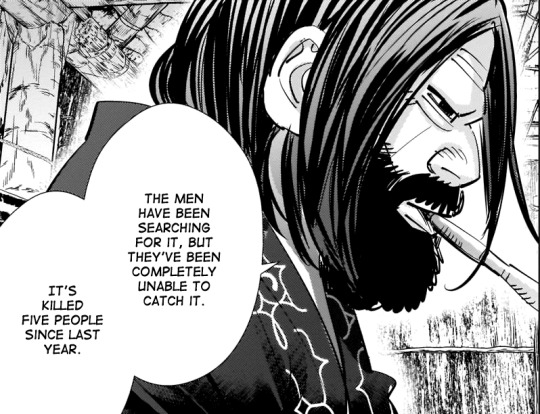
...which can also be our clue convicts had escaped the year prior to the one Asirpa and Sugimoto are.
The drunk Kadokura finds this part of the story hilarious but Kirawus instead recognizes in it the way his people deal with a Wenkamuy . They chop it into fine pieces and scatter the pieces on the mountain, while saying ‘Kaishinshiro’ [改心しろ “Convert”], they own way to lecture the Kamuy to mend its ways. According to Kirawus this is way Heita was trying to explain to Kadokura and this is also a further confirmation of how Heita was influenced in his delirium by Ainu beliefs.
An info box though tell us that the way Ainu deal with Wenkamuy varies from region to region. Kirawus was from Kushirou. Heita met the Sugimoto group on Uryugawa river, fairy distant from Kushiro but, conveniently closer, although not by much, to Abashiri and pretty close to Asahikawa.
Long story short it’s possible that Heita was from Kushirou but ended up in the Uryugawa river when the convicts escaped the men of the 7th division on their way from Abashiri to Asahikawa.
The only problem to this theory would be that Heita somehow retrieved the tobacco case and the bear pelt, so he should have gone back home... so maybe his home was on Uryugawa river in the first place and it was only convenient that place was on the way to Asahikawa from Abashiri.
Heita goes on in his story by confessing he’s glad he was captured because in this way he doesn’t get eaten/possessed by the Wenkamuy as the bear can’t reach him because he doesn’t have ‘that’ (’that’ clearly being the bear pelt that so frightened him and that he claimed he attempted to get rid many times, the bear pelt he wears when the Wenkamuy takes over his body)… and therefore the bear can’t force him to kill anyone.
It’s clear Heita, or the Heita personality, is fundamentally a person who doesn’t want to do any harm and prefers to be in a prison, sentenced to death, than free to commit murders.
However Heita admits that even in the prison he’s not safe from the Wenkamuy, that the bear is still trying to get him by controlling his body and working on plans to break Heita out of prison. He then shows Kadokura how he has ended up on having a tattoo on his body and believes he had got it while he was under the bear’s control, the visual showing us the bear peeking at Heita from the window.
This also tells us the ‘Wenkamuy’ isn’t just a ‘bear personality’, as it’s apparently clever enough he can plot escape plans and keep calm so that Heita’s body could receive a tattooo.
On a sidenote I don’t know how Nopperabou picked up the convicts for his tattooing project.
Evidently at the time Nopperabou too wasn’t kept into isolation… but still supposedly it was Asirpa who was meant to collect the skins. Sure, in Wilk’s mind he likely expected her to do it with Hijikata’s help and choosing a certain type of convicts would make harder for Tsurumi to collect them but really… it’s a plan that, more than clever, just requires a huge suspension of belief from the get go.
We know Nopperabou gave a tattoo to dangerous 24 convicts, meaning he gets to see them more than once to complete their tattoos as such big tattoo require time to be drawn.
We also know the convicts were passed their escape plan by Hijikata who, however, doesn’t know them all while Wilk apparently only tattooed them and didn’t really talk to them, some convicts, like Shiraishi, avoiding to look at him at all.
This two info however enter in conflict.
Supposedly the convicts agreed to get a tattoo because this would give them a chance to escape… unless Wilk had opened up a nice tattoo shop in Abashiri and getting a tattoo from him was considered the last fashion.
I mean, if the convicts agreed to be tattooed because this would allow them to escape and, since the escape plan was passed to them by Hijikata as Wilk only tattooed them silently or so Shiraishi said, it was Hijikata who picked them up and proposed them to get a tattoo so that they could use it to escape... so he should know them all… but no, Hijikata doesn’t know them all either.
Not mentioning in order to request for all the tattooed prisoners to be moved Tsurumi too should have gotten a list with their names on but no, he doesn’t know them all either or he would have found Youichirou immediately as the guy, after escaping, went straight home.
Besides, whoever told Tsurumi about the tattooed prisoners? Usami was a rookie learning how Abashiri worked by the time we saw him working as a guard… meaning he wasn’t around when the convicts escaped so did Tsurumi have a previous spy in the prison? And if the answer is yes, where is he now? Couldn’t he remain there? Was he among the guards who were moved away?
Oh well, hard to answer to all this now so let’s go back to Heita.
As @bloody-fabre pointed out in this ask, interestingly enough Heita’s tattoo isn’t cut in the middle of his torso but seems to continue.

A mistake from Noda’s part that will be corrected in the volume version or is there a purpose for this?
I discussed this in a more detailed way in my answer to that ask so I’ll merely send you there if you’re interested and dig into something else.
One of the kanji on Heita’s body could be read as ‘shi’ (刺). Currently we were assuming the ‘shi’ kanji that would represent the ‘shi’ part of Horokew Oshikoni was the one Gotou had but it can be the right ‘shi’ is this one. Hard to say as this is the first time that, as far as we know, someone has this kind of tattoo.
We’ll see.
Back to Kadokura, he gets thoughtful and, although he claims one would think all Heita said was something Heita made up, the truth is Heita was arrested and sentenced to death because he murdered someone and ripped apart his body while wearing a bear pelt.
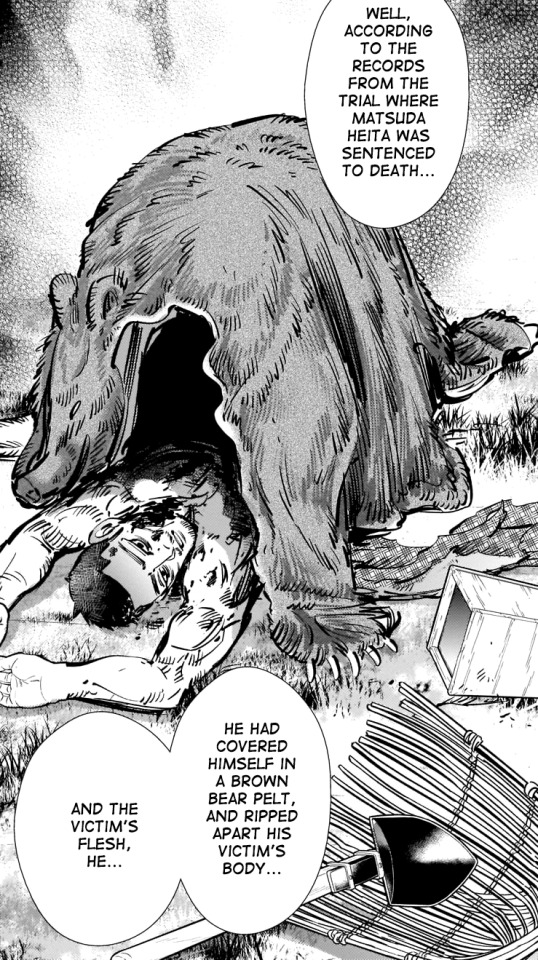
From the instruments near to the victim we can easily figure the guy was a gold panner.
Anyway this caused Heita to be called ‘Dōtō no higuma otoko' Matsuda Heita (「道東のヒグマ男」松田 平太 “Matsuda Heita, “the bear man of east Hokkaido””)... but what Kadokura also realizes is that, if what Heita told Kadokura is true, Heita might be trying to do the same again and again… which in fact is exactly what’s happening.
We switch back to Heita and Sugimoto’s fight and yes, Heita really broke Sugimoto’s arm which we can see swinging around the way Ogata’s arm did when Sugimoto broke it so, even though the visual might not have been perfectly faithful (Heita is much shorter than Sugimoto, he couldn’t have attacked him from that height) the arm breaking really happened.
Not that Sugimoto is bothered by it as he uses his rifle to… swing it at Heita, trying to hit Heita with it as if it were some sort of wand.
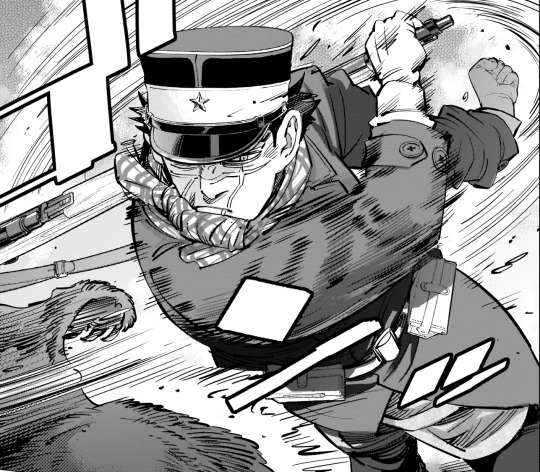
Now, it’s not a bad move, as Sugimoto really have no time to aim and shoot and probably wouldn’t have managed to do it with just one arm, but, as Sugimoto is more prone to use his rifle as if it were a club or some sort of javelin he tosses at enemies, while shooting isn’t really his strongest suit, maybe Sugimoto should consider adding a club or something similar to his equipment.
Anyway Heita fights exactly like a ferocious bear. He bits Sugimoto’s good arm...
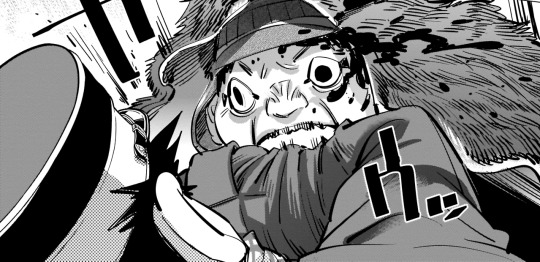
and causes them both to roll off the mountain and down a cliff (the whole thing ironically reminds me of Sugimoto’s meeting with Ogata in which he broke Ogata’s arm and caused him to fall off a cliff by hitting him with his rifle… but it’s probably just a coincidental parallelism) a tree probably breaking their fall so they don’t exactly slam straight on the ground from the cliff.
As Sugimoto falls Shiraishi reaches Asirpa with Vasily’s draw in his hand, asking where Heita is and telling her Heita is a tattooed convict.
Meanwhile we discover that Sugimoto’s rifle remained trapped in the branches of the tree while Sugimoto and Heita reached the ground and Heita is again jumping on Sugimoto, impressing Sugimoto with his terrible strength... which is quite a feat really as I remember the only people who managed to impress him previously were Ushiyama and Gansoku.
As Heita growls like a bear, trying to bite Sugimoto again, Sugimoto keeps him away with his foot and retrieve his bayonet, with whom he stabs him multiple times, same as he did with Henmi.
The visual shows us the bear screaming… and then, from his mouth two hands emerge, one of them pulling the rope close to Sugimoto’s head,

rope which we’ve come to associate to an amappo trap, which, predictably, fires. However, as it’s about to hit Sugimoto, Heita gets in between, and is stabbed in his neck.

Sugimoto is surprised as Heita falls and Asirpa and Shiraishi reach them.
Heita comments he finally beats ‘it’, ‘it’ being the Wenkamuy. As Asirpa realizes that was the place in which the Amappo trap that almost killed Vasily was, Heita explains he basically tried to lead the Wenkamuy there on purpose... meaning he has some vague measure of awareness and control on the Wenkamuy, at least as he and Sugimoto were fighting.
Shiraishi would like for Asirpa to save Heita from the arrow… but Heita doesn’t want to be saved.
He explains when he was 12 he heard the story of the Wenkamuy from the Ainu. The visual focuses on the cigarette case, as if to imply he got it in that circumstance. The whole story scared him a lot yet he was always fantasizing about it.
Then Heita switches to talk about his family. Even if he worked hard to pan gold, his family would have wasted it all in a single day.
It’s worth to note here Heita is using ‘Watashi’ (私) to refer to himself.
私が汗水ながして砂金を掘ってもその日のうちに散在する家族たち.
Watashi ga asemizu nagashite sakin o hotte mo sonohi no uchi ni sanzai suru kazoku-tachi.
“Even if I sweat to pan gold dust, my family would waste it all in a single day day.”
Heita claims this digusted him and he wanted to punish those greedy, ugly guys who were blinded by gold...

until one day, FINALLY, HIS Wenkamuy killed his whole family.

Yes, Heita says
‘his’
Wenkamuy or, more specifically he says:
僕のウェンカムイが家族を全員殺してしまった
Boku no Wenkamui ga kazoku o zen'in koroshite shimatta
“My Wenkamuy killed my entire family.”
Yes, he has switched again to using ‘boku’. This can be our hint that, when his family was killed by the Wenkamuy he was pretty young and also, in the past, when he used ‘boku’ he was merely reliving what had happened to his family when he was younger. Was he only 12 when this happened? Or did he manage to get a little older? Hard to say as there’s no visual showing us how Heita was at the time.
Anyway, although Heita is clearly telling us the truth, the situation is deliberately unclear. Does he defines the ‘wenkamuy’ as HIS because he’s admitting he was the one doing the slaughtering or is he calling it as such because he fantasized about it to the point he believes a real bear has become his own Wenkamuy and he had called it?
It’s hard to say, the slaughtering of his own family at the hands of a real bear as well as a misplaced sense of guilt could be the drama that caused Heita’s mind to shatter and reduce him the way he is now… or he could have shattered much earlier, as it’s pretty clear he has no love for his family and views it as ugly and greedy from when he was pretty young, so it’s possible they might have abused him as a common characteristic of who suffer of DID in real life is that a great percentage of them also suffered of abuse.
There’s no doubt though his story is told in a rather rushed manner to fit the 18 pages which constitute the lenght of each Golden Kamuy chapter printed in the magazine and I think, very likely, it be expanded in the volume version as it happened to other convicts (see Youichirou or Sekiya for example).
Heita switched again to Watashi as he says ‘the greedy me’ was also eaten in punishment by the Wenkamuy as well.
そして欲深い私も罰として食べられ・・・
Soshite yokubukai watashi mo batsu to shite taberare…
“Then it ate the greedy me in punishment...”
Is Heita defining himself greedy because he wanted Noriko for himself as in his hallucination/flashback we saw him trying to kiss her?
Or he views himself as greedy because he too wanted the gold and this is why he was mad with his family who wasted it and wanted it to be murdered?
Hard to say with the little info we have.
Heita continues saying that after he was eaten by the Wenkamuy he turned into a Wenkamuy as well and went off to eat someone… but he wanted to stop this.
Rather long ago I made a post titled ‘Do the Golden Kamuy characters feel guilty when killing people?’.
Heita, like many other characters, in his own way confirms he too felt guilty for what he did, even though each time he murdered he apparently lost control of himself.
Not only Heita believed he too needed to be devoured in punishment by the Wenkamuy...
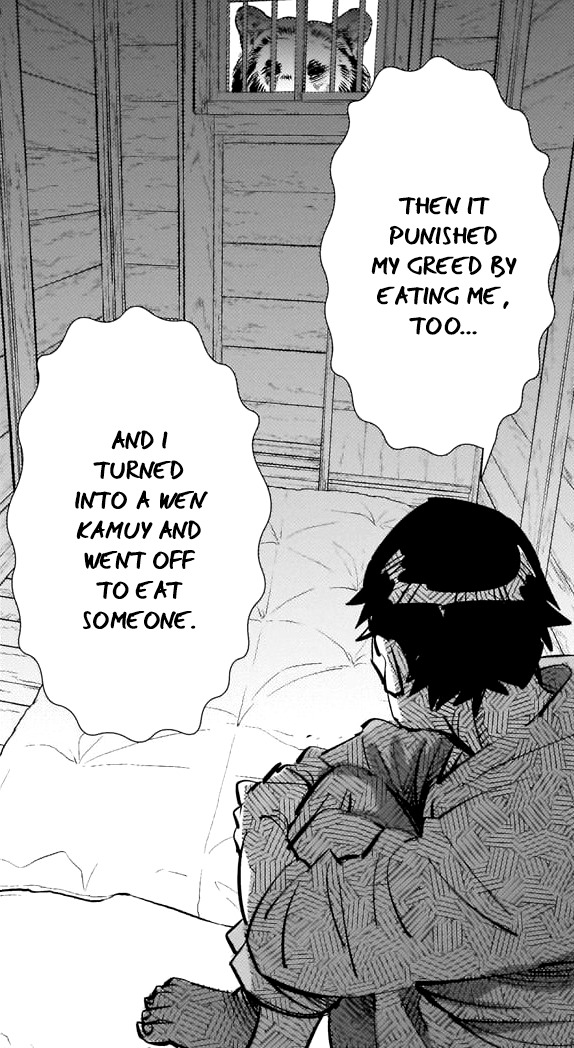
...but he told Sugimoto and Asirpa to escape when he met them after he re-lived the murder of his whole family,
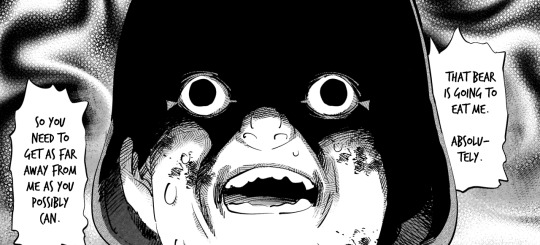
a sign he didn’t want to kill them, and the whole thing with the Amappo trap is, ultimately, Heita’s desperate way to stop himself from murdering Sugimoto.
In fact his last words are for Sugimoto. He thanks ‘Sugimoto-san’ for fighting him, so that he finally managed to stop himself (by killing himself).
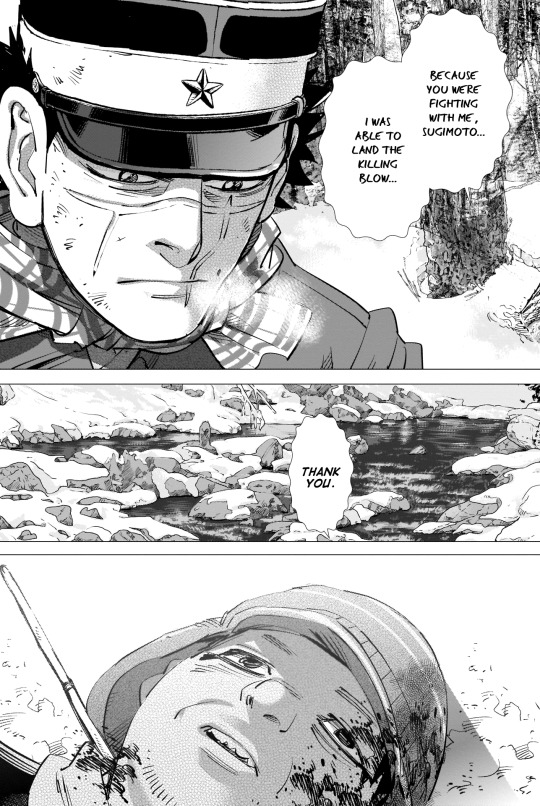
In a way Heita’s story is tragic. He’s a guy whose mental illness forced him to commit crimes he didn’t want to commit. The poor guy only wanted to be stopped.
After thanking Sugimoto Heita dies.
Asirpa explains Heita’s understanding of the story of the Wenkamuy was wrong.
According to her, in her region, people think that the ones killed by the Wenkamuy are killed, not in punishment, but because ‘they were liked by the kamuy’.
Basically she thinks Heita misunderstood or didn’t know in full the story told by the Ainu and let grow inside himself the wrong type of Wenkamuy.
Due to this Asirpa concludes it’s important to communicate things correctly.
As she says so Asirpa is likely thinking at her own culture… which she wants to save and pass down... and which ended up being tied to Heita’s demise... but in this manga it can have a double meaning as a lot of people here don’t convey things correctly or don’t convey things at all, among which there are Asirpa and Sugimoto themselves.
I’m really curious to know if this chapter will work as the opening to them reaching a better understanding of each other by talking more.
Sugimoto, who instead has no real worry for Ainu culture, focuses on the gold and Heita’s madness.
He wonders if it was the greed for gold that turned Heita’s life into madness…

Or there’s a magical power in the gold that turn people mad?
As he says the last sentence we’re shown Tsurumi, whose background behind him could be Otaru but it’s really hard to say, Hijikata, whose background behind him I can’t recognize and Ogata, whose background behind him is the one of the outside of Hijikata’s hideout in Otaru… though again it could also be a random building who looks like it.
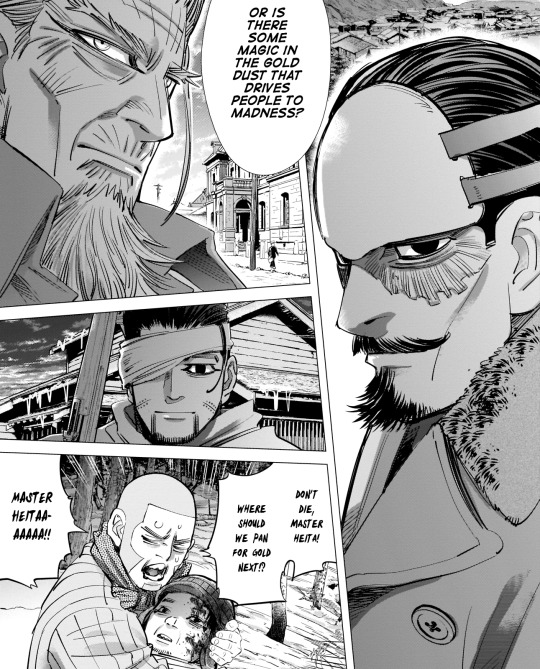
Hard to say.
The last person we’re shown is Shiraishi who hugs Heita and begs him not to die before telling him where he should pan next, as if to imply he is a guy who would care only about the gold and not about Heita’s death.
Likely the scene is meant to lighten the spirit, even if I can’t say I find it that funny as I really can’t think Shiraishi would mourn Heita only due to Heita being tied to the gold.
Anyway… going in reverse order I’ll focus first on the last page and then I’ll go back a little.
The fact that Ogata is back in Otaru is an interesting possibility.

Although he was actually in an alliance with Kiro and Hijikata could have guessed it, it’s hard to figure if Hijikata has the means to prove it as Hijikata likely didn’t get to hear Inkarmat’s story and it’s unlikely Ariko knew about it and could report it to Hijikata.
Long story short, Hijikata might not know Nopperabou was shoot by ‘a sniper’ and Ogata could claim he merely escaped with Kiro following the escape plan they had prepared previously together. After all he didn’t exactly swore to follow Hijikata through thick and thin and Hijikata was currently missing, likely busy hiding from Tsurumi’s men with Ushiyama, Kantarou and Toni Anji.
Besides it’s not like Hijikata can claim to be a perfectly loyal boy, not after he had used Sugimoto as a bait in cooperation with Kadokura and Toni Anji.
On the other side, attempting to resume a cooperation with Hijikata would require quite an amount of risk as yes, the possibility Hijikata figured out Ogata was actually working with Kiro to kill Wilk and steal Asirpa is HUGE and since Ogata is a poor liar he might not want to have to defend himself form such accusation.
So yes, while it’s possible Ogata will want to resume a cooperation with Hijikata… is also possible he went there to check the place without meeting anyone as the hideout is BEHIND Ogata meaning he’s leaving it… unless he’s actually meeting someone outside of it.
Hard to say as I can’t figure out where Hijikata is.
Anyway, all this reminds me that Tsurumi planned to post on the newspaper some fake news regarding the death of Asirpa’s grandmother.

While Asirpa likely hadn’t read any newspaper (it was told long ago Asirpa didn’t know how to read, although she might have learnt to recognize the kanji on the convicts’ skins as she figured out correctly which were the relevant ones on Gotou, prisoner number 1 and Shiraishi) it seems no one who knows how to read had the chance to read a newspaper and report the info to her as they had hid in Ainu villages where there was apparently shortage of newspapers.
So, unless Heita had a newspaper and the guys will read it now, it almost seems as if the whole plan was a moot point.
It could be, Tsurumi wasn’t putting much faith in it… but on the other side Hijikata read newspapers and could be interested in checking this as he could try to use the info to win Asirpa over to his cause. On the other side we also have Ogata who has a weakness for grandmothers so he could end up being involved in this as well.
We’ll see.
So let’s go back into the chapter a little more.
This arc ends again with Sugimoto wondering about something, namely the connection between gold and madness. He’s unsure if madness is caused by greed or gold just has a ‘magical power’ that turn people mad.
Sure, it could be just a reference to the title, ‘Golden Kamuy’ which imply the gold is a ‘kamuy’, where ‘kamuy’ for the Ainu are ‘all the things that are useful’ but also ‘all the things with power beyond their control’.
The gold can, of course, be labelled as a ‘kamuy’ because useful... but now Sugimoto is wondering if it actually has a power beyond their control.
Personally I don’t like much this idea because it discharges the men’s responsability in being greedy and places the blame on the gold, which would just drive them to insanity.
Of course it can also be Noda’s way to remark again the difference between Sugimoto and Ogata. Ogata is a guy who strongly believes in the relation between cause and effect. It’s not the kamuy who save people, it’s the Orok’s hat and him shooting to the Russian border guards’ leader. Sugimoto instead is more prone to think into magic and divine punishment, like how he assumed through the whole chapter that the bear was sent by the gods of the mountain to punish them for not sending off the bear properly.
I wonder if this is going to turn out relevant in the future… or it’s just a mere characteristic of the two of them… and let’s keep on talking of them as Heita, with his uncontrollable Wenkamuy reminds me of Sugimoto and how he lost it while fighting Gansoku.
Is Sugimoto going to lose it again?
Is the Heita arc going to foreshadow that? Sugimoto losing complete control of himself and his friends having to find a way to bring him back?
It could be interesting, Sugimoto’s loss of control was touched only once… it would be good to see it again and, this time, being handled by his friends and not just by people who were to tell him they’ll kill him if he were to lose it again (albeit I like to think Tsukishima did it to try and motivate Sugimoto not to lose it again…).
On the other side the only other character who attempted ‘suicide’, albeit indirectly, is Ogata when he tried to persuade Asirpa to shoot him… and while Heita’s actions were tied to him misunderstanding the Wenkamuy’s story, Ogata’s actions were also tied to him mistakenly thinking Asirpa had been set up to be the Ainu’s idol… never mention both Heita and Ogata started their wrong path when they both were pretty young.
So this small arc of apparently little importance could actually be meant to work as a bridge to introduce us to the future development of both Ogata and Sugimoto or of just one of them.
Personally I’ll be glad if we’ll learn more on either of those two as I’m greedy for more info about Sugimoto or Ogata. It might be just me though but they’re both in interesting situations with Ogata back in Hokkaido and, possibly, in Otaru and Sugimoto now with his arm broken… poor Sugimoto out of late seems to have troubles not to end up seriously injured… the past time it was bullet wounds, now it’s a broken arm… he’s really not having it easy.
Anyway Noda is taking a break so next week there sadly will be no chapter. We’ll see what he’s preparing for us.
He still has only four convicts to reveal and if he’ll handle them as fast as he did with Heita we might be closer to the ending than we’ve assumed.
We sadly can only wait.
#Golden Kamuy#Sugimoto Saichi#Asirpa#Ogata Hyakunosuke#Shiraishi Yoshitake#Matsuda Heita#Tsurumi Tokushirou#Hijikata Toshizou#Golden Kamuy Ramblings and Theories#Matsuda Taka#Matsuda Jirou#Matsuda Noriko
25 notes
·
View notes
Text
Headlines
Social distancing could last months, White House coronavirus coordinator says
(Washington Post) Some form of social distancing will probably remain in place through the summer, Deborah Birx, the White House’s coronavirus task force coordinator, said Sunday—the same day several governors expressed optimism about the course of the virus and outlined their plans for a piecemeal reopening of their economies. After weeks of being told to simply stay home to halt the spread of the virus, individuals and business owners are now facing more complex decisions about how to proceed. In places where restaurant dining rooms are reopening, is it safe to go? Is it a good idea to return to the hair salon for a much-needed trim? And for business owners facing a litany of new guidelines about how to reopen without endangering their workers or customers, are the risks worth it?
Las Vegas and the jobs crisis
(NYT) As the bottom fell out of the American economy, few places were hit harder than Las Vegas, where a full one-third of the local economy is in the leisure and hospitality industry, more than in any other major metropolitan area in the country. Most of those jobs cannot be done from home. Nearly 350,000 people in Nevada have filed for unemployment benefits since the crisis began, the highest number in the history of the state. Applied Analysis, a Las Vegas-based economic research firm, estimates the city’s current jobless rate to be about 25 percent—nearly double what it was during the Great Recession—and rising. “From an analytical standpoint, this is unprecedented,” said Jeremy Aguero, a principal analyst with the firm. “We have no frame of reference for what we are seeing.” Before the crisis, Nevada’s economy was one of the fastest growing in the country. Then, practically overnight, the glittering Vegas strip shut down, throwing thousands of waiters, bartenders, hotel cleaners and casino workers out of work, often without severance or benefits, and leaving the most bustling and storied stretch of the state’s economy boarded up and empty.
Bolsonaro Pulls Back Justice Minister Pick as Critics Cry Foul
(Foreign Policy) Brazilian President Jair Bolsonaro has postponed the appointment of a new justice minister after numerous news reports suggested Bolsonaro loyalist Jorge Oliveira would be the favorite for the role. The decision follows an explosive few days at the top of Brazilian politics as allegations of presidential corruption mount and public confidence in Bolsonaro’s handling of the country’s coronavirus epidemic crumbles. The latest episode began on Friday with the abrupt resignation of Justice Minister Sergio Moro, after Bolsonaro had fired the head of Brazil’s equivalent to the FBI, Maurício Valeixo. In his resignation press conference, Moro alleged Bolsonaro had fired Valeixo for personal and political reasons relating to ongoing federal investigations into Bolsonaro’s children. Immediately following Moro’s remarks, Brazil’s chief prosecutor asked the Supreme Court to authorize an investigation of Moro’s accusations against Bolsonaro. Writing in FP last week, Eduardo Mello observed that Brazilian lawmakers will be loath to remove Bolsonaro if that risks empowering Vice President Hamilton Mourão, a retired four-star general. “While most in Congress know that Bolsonaro’s populist rhetoric is a threat to them, they also think that having a general with no links to the country’s political power brokers is a bigger risk at the moment,” he wrote.
Chile plans coronavirus certificates
(Foreign Policy) Chile is moving forward with a plan to issue “release certificates” to those who have recovered from the coronavirus. The plan, according to Chile’s top health official, Jaime Manalich, would mean holders would be “freed from all types of quarantine or restriction, specifically because they can help their communities enormously since they pose no risk.”
Virus spreads fear through Latin America’s unruly prisons
(AP) The spreading specter of the new coronavirus is shaking Latin America’s notoriously overcrowded, unruly prisons, threatening to turn them into an inferno. The Puente Alto prison in downtown Santiago, Chile, had the largest of Latin America’s largest prison virus outbreaks so far, with more than 300 reported cases. The prison’s 1,100 inmates are terrified. Social distancing is hard to practice in jail. Latin America’s prisons hold 1.5 million inmates, and the facilities are often quasi-ruled by prisoners themselves because of corruption, intimidation and inadequate guard staffs. Low budgets also create ideal conditions for the virus to spread: There is often little soap and water and cell blocks are crowded.
As Europe confronts coronavirus, the media faces a trust test
(Nieman Reports) By and large, European COVID-19 coverage is not increasing the public’s trust in the media. In an Edelman survey, journalists were the least trusted information source on the coronavirus, falling behind politicians and healthcare CEOs. This response follows five years of declining trust in the European Union’s media, and in some countries, the numbers are quite stark. About a week into Italy’s COVID-19 lockdown, a TradeLab study found that only 16 percent of those surveyed believed news on the pandemic was balanced and transparent.
Dutch teens sail across Atlantic after becoming stranded in Caribbean
(Washington Post) When the global pandemic made air travel impossible, a group of Dutch high school students stranded in the Caribbean got home the old-fashioned way—sailing a 200-foot schooner across the Atlantic. The 25 teenagers on board the Wylde Swan sailed into the port of Harlingen and were reunited with their families on Sunday, roughly five weeks after leaving the island of Saint Lucia. Many of the students had minimal sailing experience when they signed up for an educational program aboard the two-masted schooner and had anticipated spending only six weeks cruising the relatively calm waters of the Caribbean. They eventually embarked on a journey of nearly 4,500 nautical miles across the ocean. Along the way, the students gradually got past their seasickness and watched dolphins swim alongside the vessel. One 17-year-old told the Omrop Fryslan Dutch radio station that it had been “an even more exciting journey than what I had signed up for.”
Face masks become mandatory in public across most of Germany
(Washington Post) Most federal states across Germany implemented rules on the wearing of face masks in public on Monday, amid hopes that it will allow businesses to reopen without sparking a second wave of infections. The details differ between federal states. For instance in Berlin, face masks are mandatory on public transport, but violating the rule will not be penalized. In Munich and other cities, however, the rules are expected to be more strictly enforced with hefty fines. Face masks are now also mandatory in supermarkets and other shops across much of the country.
Dry Germany, drying Rhine
(Bloomberg) Germany’s spring showers haven’t materialized this year, and that’s drying out the country’s most important river (the Rhine), prompting concerns that key industrial goods might have trouble making it to their destination. Typically one of the wettest months, Europe’s biggest economy has received just 5% of its normal April rainfall so far, according to Germany’s federal weather service. It’s on course to be the driest month since records began in 1881.
The right to work from home
(Bild am Sonntag) German Labor and Social Affairs Minister Hubertus Heil has called to enshrine the right to work from home into German law, in a move that could become more common as advanced economies emerge from their coronavirus epidemics. “Anyone who wants to, and whose workplace allows it, should be able to work at home—even when the coronavirus pandemic is over,” Heil told Bild am Sonntag.
Saving Czech pubs
(Worldcrunch) With more than 90% of pubs closed due to lockdown measures, the Czech Republic has been deprived of an emblematic part of its culture. In response, Czechs have spent 7 million CZK (257,124 euro) since the beginning of April on beer and food vouchers to be consumed in better times, reported iROZHLAS.cz. Started by the Czech Beer and Malt Association, the site “Zachraň svou hospodu!” (Save Your Pub!) enables concerned drinkers to buy vouchers in order to support their favorite bars and restaurants through the coronavirus shutdown, and use them whenever the cash-strapped pubs reopen.
Mideast economies take massive hit with oil price crash
(AP) Iraq is planning painful cuts in social benefits relied on by millions of government workers. Saudi Arabia will likely have to delay mega-projects. Egypt and Lebanon face a blow as their workers in the Gulf send back less of the much-needed dollars that help keep their fragile economies afloat. The historic crash in oil prices in the wake of the coronavirus pandemic is reverberating across the Middle East as crude-dependent countries scramble to offset losses from a key source of state revenue—and all this at a time when several of them already face explosive social unrest. While some Gulf countries can rely on a cushion of foreign currency reserves, nowhere in the region are the circumstances more dire than in Iraq, where oil sales fund 90% of the state budget. Iraq saw massive protests in the past months by a populace angry over the weak economy and rampant corruption—and the turmoil could erupt again. Cutbacks in spending will only add to the pain for a population struggling to get by under coronavirus restrictions.
Lebanese defy coronavirus lockdown and block roads, protesting deteriorating economy
(AP) Protesters took the streets across Lebanon late Sunday, blocking roads and highways to protest the worsening economy, in defiance of a coronavirus-triggered lockdown and curfew imposed by authorities, according to the country’s official news agency. Sunday’s demonstrations were the latest to rock Lebanon in recent days, even as a lockdown and a dusk-to-dawn curfew remained in place. The coronavirus pandemic has deepened Lebanon’s worst economic crisis since the nation’s 15 year civil war that ended in 1990. Since October, hundreds of thousands have demonstrated against the government and its elites, decrying corruption and other mismanagement that has crippled the economy.
Netanyahu confident of U.S. backing on annexation
(Foreign Policy) On Sunday, Benjamin Netanyahu told a pro-Israel Christian group, the European Commission for Israel, that he was confident the United States would give its blessing to a planned annexation of parts of the occupied West Bank in a matter of months. A condition of Netanyahu’s newly formed coalition with Benny Gantz is that Washington must approve any annexation decision first. Writing in Foreign Policy on April 23, a trio of seasoned Israeli military commanders warned Netanyahu against such a move. Ami Ayalon (a former chief of the Israeli Shin Bet security service), Tamir Pardo (a former director of the Mossad), and Gadi Shamni (a former commander of the Israel Defense Forces Central Command) argued that annexation would undermine Israeli security and could spark a popular backlash in Jordan and Egypt—endangering hard-won peace treaties with those countries. “This irreversible step, once taken, is likely to trigger a chain reaction beyond Israel’s control,” they wrote.
1 note
·
View note
Text
The 1619 Project https://nyti.ms/2Hjvu0L
The 1619 Project is a major initiative from The New York Times observing the 400th anniversary of the beginning of American slavery. It aims to reframe the country’s history, understanding 1619 as our true founding, and placing the consequences of slavery and the contributions of black Americans at the very center of the story we tell ourselves about who we are.
"We asked 16 writers to bring consequential moments in African-American history to life. Here are their poems and stories:"
Published August 14, 2019 | "1619 Project" New York Times | Posted August 16, 2019 |
⬤ August 1619
A poem by Clint Smith
In Aug. 1619, a ship arrived in Point Comfort, Va., carrying more than 20 enslaved Africans, the first on record to be brought to the English colony of Virginia. They were among the 12.5 million Africans forced into the trans-Atlantic slave trade, their journey to the New World today known as the Middle Passage.
Over the course of 350 years,
36,000 slave ships crossed the Atlantic
Ocean. I walk over to the globe & move
my finger back & forth between
the fragile continents. I try to keep
count how many times I drag
my hand across the bristled
hemispheres, but grow weary of chasing
a history that swallowed me.
For every hundred people who were
captured & enslaved, forty died before they
ever reached the New World.
I pull my index finger from Angola
to Brazil & feel the bodies jumping from
the ship.
I drag my thumb from Ghana
to Jamaica & feel the weight of dysentery
make an anvil of my touch.
I slide my ring finger from Senegal
to South Carolina & feel the ocean
separate a million families.
The soft hum of history spins
on its tilted axis. A cavalcade of ghost ships
wash their hands of all they carried.
Clint Smith is a doctoral candidate at Harvard University and the author of the poetry collection “Counting Descent,” as well as a forthcoming nonfiction book, “How the Word Is Passed.” Photo illustration by Jon Key. Diagram: Getty Images.
⬤ March 5, 1770
A poem by Yusef Komunyakaa
In 1770, Crispus Attucks, a fugitive from slavery who worked as dockworker, became the first American to die for the cause of independence after being shot in a clash with British troops.
African & Natick blood-born
known along paths up & down
Boston Harbor, escaped slave,
harpooner & rope maker,
he never dreamt a pursuit of happiness
or destiny, yet rallied
beside patriots who hurled a fury
of snowballs, craggy dirt-frozen
chunks of ice, & oyster shells
at the stout flank of redcoats,
as the 29th Regiment of Foot
aimed muskets, waiting for fire!
How often had he walked, gazing
down at gray timbers of the wharf,
as if to find a lost copper coin?
Wind deviled cold air as he stood
leaning on his hardwood stick,
& then two lead bullets
tore his chest, blood reddening snow
on King Street, March 5, 1770,
first to fall on captain’s command.
Five colonists lay for calling hours
in Faneuil Hall before sharing a grave
at the Granary Burying Ground.
They had laid a foundering stone
for the Minutemen at Lexington
& Concord, first to defy & die,
& an echo of the future rose over
the courtroom as John Adams
defended the Brits, calling the dead
a “motley rabble of saucy boys,
negroes & mulattoes, Irish
teagues & outlandish jacktars,”
who made soldiers fear for their lives,
& at day’s end only two would pay
with the branding of their thumbs.
Yusef Komunyakaa is a poet whose books include “The Emperor of Water Clocks” and “Neon Vernacular,” for which he received the Pulitzer Prize. He teaches at N.Y.U. Photo illustration by Jon Key. Boston Massacre: National Archives. Attucks: Getty Images.
⬤ 1773
A poem by Eve L. Ewing
In 1773, a publishing house in London released “Poems on Various Subjects, Religious and Moral,” by Phillis Wheatley, a 20-year-old enslaved woman in Boston, making her the first African-American to publish a book of poetry.
Pretend I wrote this at your grave.
Pretend the grave is marked. Pretend we know where it is.
Copp’s Hill, say. I have been there and you might be.
Foremother, your name is the boat that brought you.
Pretend I see it in the stone, with a gruesome cherub.
Children come with thin paper and charcoal to touch you.
Pretend it drizzles and a man in an ugly plastic poncho
circles the Mathers, all but sniffing the air warily.
We don’t need to pretend for this part.
There is a plaque in the grass for Increase, and Cotton.
And Samuel, dead at 78, final son, who was there
on the day when they came looking for proof.
Eighteen of them watched you and they signed to say:
the Poems specified in the following Page, were (as we verily believe)
written by Phillis, a young Negro Girl, who was but a few Years since,
brought an uncultivated Barbarian from Africa
and the abolitionists cheered at the blow to Kant
the Negroes of Africa have by nature no feeling that rises above the trifling
and the enlightened ones bellowed at the strike against Hume
no ingenious manufacturers amongst them, no arts, no sciences
Pretend I was there with you, Phillis, when you asked in a letter to no one:
How many iambs to be a real human girl?
Which turn of phrase evidences a righteous heart?
If I know of Ovid may I keep my children?
Pretend that on your grave there is a date
and it is so long before my heroes came along to call you a coon
for the praises you sang of your captors
who took you on discount because they assumed you would die
that it never ever hurt your feelings.
Or pretend you did not love America.
Phillis, I would like to think that after you were released unto the world,
when they jailed your husband for his debts
and you lay in the maid’s quarters at night,
a free and poor woman with your last living boy,
that you thought of the Metamorphoses,
making the sign of Arachne in the tangle of your fingers.
And here, after all, lay the proof:
The man in the plastic runs a thumb over stone. The gray is slick and tough.
Phillis Wheatley: thirty-one. Had misery enough.
Eve L. Ewing is the author of “1919,” the “Ironheart” series, “Ghosts in the Schoolyard: Racism and School Closings on Chicago’s South Side” and “Electric Arches.” She is a professor at the University of Chicago.
⬤ Aug. 30, 1800
Fiction by Barry Jenkins
In 1800, Gabriel Prosser, a 24-year-old literate blacksmith, organized one of the most extensively planned slave rebellions, with the intention of forming an independent black state in Virginia. After other enslaved people shared details of his plot, Gabriel’s Rebellion was thwarted. He was later tried, found guilty and hanged.
As he approached the Brook Swamp beneath the city of Richmond, Va., Gabriel Prosser looked to the sky. Up above, the clouds coalesced into an impenetrable black, bringing on darkness and a storm the ferocity of which the region had scarcely seen. He may have cried and he may have prayed but the thing Gabriel did not do was turn back. He was expecting fire on this night and would make no concessions for the coming rain.
And he was not alone. A hundred men; 500 men; a thousand men had gathered from all over the state on this 30th day of August 1800. Black men, African men — men from the fields and men from the house, men from the church and the smithy — men who could be called many things but after this night would not be called slaves gathered in the flooding basin armed with scythes, swords, bayonets and smuggled guns.
One of the men tested the rising water, citing the Gospel of John: “For an angel went down at a certain season into the pool, and troubled the water: whosoever then first after the troubling of the water stepped in was made whole of whatsoever disease he had.” But the water would not abate. As the night wore on and the storm persisted, Gabriel was overcome by a dawning truth: The Gospel would not save him. His army could not pass.
Gov. James Monroe was expecting them. Having returned from his appointment to France and built his sweeping Highland plantation on the periphery of Charlottesville, Monroe wrote to his mentor Thomas Jefferson seeking advice on his “fears of a negro insurrection.” When the Negroes Tom and Pharoah of the Sheppard plantation betrayed Gabriel’s plot on a Saturday morning, Monroe was not surprised. By virtue of the privilege bestowed upon him as his birthright, he was expecting them.
Gabriel Prosser was executed Oct. 10, 1800. Eighteen hundred; the year Denmark Vesey bought his freedom, the year of John Brown’s and Nat Turner’s births. As he awaited the gallows near the foot of the James River, Gabriel could see all that was not to be — the first wave of men tasked to set fire to the city perimeter, the second to fell a city weakened by the diversion; the governor’s mansion, James Monroe brought to heel and served a lash for every man, woman and child enslaved on his Highland plantation; the Quakers, Methodists, Frenchmen and poor whites who would take up with his army and create a more perfect union from which they would spread the infection of freedom — Gabriel saw it all.
He even saw Tom and Pharoah, manumitted by the government of Virginia, a thousand dollars to their master as recompense; a thousand dollars for the sabotage of Gabriel’s thousand men. He did not see the other 25 men in his party executed. Instead, he saw Monroe in an audience he wanted no part of and paid little notice to. For Gabriel Prosser the blacksmith, leader of men and accepting no master’s name, had stepped into the troubled water. To the very last, he was whole. He was free.
Barry Jenkins was born and raised in Miami. He is a director and writer known for his adaptation of James Baldwin’s “If Beale Street Could Talk” and “Moonlight,” which won the Academy Award for Best Picture. Photo illustration by Jon Key. House: Sergey Golub via Wikimedia. Landscape, right: Peter Traub via Wikimedia.
⬤ Jan. 1, 1808
Fiction by Jesmyn Ward
In 1808, the Act Prohibiting Importation of Slaves went into effect, banning the importation of enslaved people from abroad. But more than one million enslaved people who could be bought and sold were already in the country, and the breaking up of black families continued.
The whisper run through the quarters like a river swelling to flood. We passed the story to each other in the night in our pallets, in the day over the well, in the fields as we pulled at the fallow earth. They ain’t stealing us from over the water no more. We dreamed of those we was stolen from: our mothers who oiled and braided our hair to our scalps, our fathers who cut our first staffs, our sisters and brothers who we pinched for tattling on us, and we felt a cool light wind move through us for one breath. Felt like ease to imagine they remained, had not been stolen, would never be.
That be a foolish thing. We thought this later when the first Georgia Man come and roped us. Grabbed a girl on her way for morning water. Snatched a boy running to the stables. A woman after she left her babies blinking awake in their sack blankets. A man sharpening a hoe. They always came before dawn for us chosen to be sold south.
We didn’t understand what it would be like, couldn’t think beyond the panic, the prying, the crying, the begging and the screaming, the endless screaming from the mouth and beyond. Sounding through the whole body, breaking the heart with its volume. A blood keen. But the ones that owned and sold us was deaf to it. Was unfeeling of the tugging the children did on their fathers’ arms or the glance of a sister’s palm over her sold sister’s face for the last time. But we was all feeling, all seeing, all hearing, all smelling: We felt it for the terrible dying it was. Knowed we was walking out of one life and into another. An afterlife in a burning place.
The farther we marched, the hotter it got. Our skin grew around the rope. Our muscles melted to nothing. Our fat to bone. The land rolled to a flat bog, and in the middle of it, a city called New Orleans. When we shuffled into that town of the dead, they put us in pens. Fattened us. Tried to disguise our limps, oiled the pallor of sickness out of our skins, raped us to assess our soft parts, then told us lies about ourselves to make us into easier sells. Was told to answer yes when they asked us if we were master seamstresses, blacksmiths or lady’s maids. Was told to disavow the wives we thought we heard calling our names when we first woke in the morning, the husbands we imagined lying with us, chest to back, while the night’s torches burned, the children whose eyelashes we thought we could still feel on our cheeks when the rain turned to a fine mist while we stood in lines outside the pens waiting for our next hell to take legs and seek us out.
Trade our past lives for new deaths.
Jesmyn Ward is the author of “Sing, Unburied, Sing,” which won a National Book Award. She was a 2017 MacArthur fellow. Photo illustration by Jon Key. Landscape: Peter Traub via Wikimedia.
⬤ July 27, 1816
A poem by Tyehimba Jess
In 1816, American troops attacked Negro Fort, a stockade in Spanish Florida established by the British and left to the Black Seminoles, a Native American nation of Creek refugees, free black people and fugitives from slavery. Nearly all the soldiers, women and children in the fort were killed.
They weren’t headed north to freedom —
They fled away from the North Star,
turned their back on the Mason-Dixon line,
put their feet to freedom by fleeing
further south to Florida.
Ran to where ’gator and viper roamed
free in the mosquito swarm of Suwannee.
They slipped out deep after sunset,
shadow to shadow, shoulder to shoulder,
stealthing southward, stealing themselves,
steeling their souls to run steel
through any slave catcher who’d dare
try stealing them back north.
They billeted in swamp mud,
saw grass and cypress —
they waded through waves
of water lily and duckweed.
They thinned themselves in thickets
and thorn bush hiding their young
from thieves of black skin marauding
under moonlight and cloud cover.
Many once knew another shore
an ocean away, whose language,
songs, stories were outlawed
on plantation ground. In swampland,
they raised flags of their native tongues
above whisper smoke
into billowing bonfires
of chant, drum and chatter.
They remembered themselves
with their own words
bleeding into English,
bonding into Spanish,
singing in Creek and Creole.
With their sweat
forging farms in
unforgiving heat,
never forgetting scars
of the lash, fighting
battle after battle
for generations.
Creeks called them Seminole
when they bonded with renegade Creeks.
Spaniards called them cimarrones,
runaways — escapees from Carolina
plantation death-prisons.
English simply called them maroons,
flattening the Spanish to make them
seem alone, abandoned, adrift —
but they were bonded,
side by side,
Black and Red,
in a blood red hue —
maroon.
Sovereignty soldiers,
Black refugees,
self-abolitionists, fighting
through America’s history,
marooned in a land
they made their own,
acre after acre,
plot after plot,
war after war,
life after life.
They fought only
for America to let them be
marooned — left alone —
in their own unchained,
singing,
worthy
blood.
Tyehimba Jess is a poet from Detroit who teaches at the College of Staten Island. He is the author of two books of poetry, “Leadbelly” and “Olio,” for which he received the 2017 Pulitzer Prize. Photo illustration by Jon Key. Cypress: Ron Clausen via Wikimedia
2 notes
·
View notes